PART 2
(Full evidence is located here. Snippets of information have been created to condense this report. Please feel free to browse all reports and evidence.)
Questions? behindthefireorg@gmail.com
Part 2 of Behindthefire.org’s investigation into the house fire at 7809 Winans Lake Road will take a slightly different approach. While Part 1 focused heavily on evidence and facts with limited opinions, Part 2 will present a combination of evidence, facts, and opinions.
The first section of Part 2 will delve deeper into the narratives , data tabulation and testimony. The second section will introduce newly acquired or presented information that has been thoroughly verified and fact-checked.
Some information may be redacted due to attorney or legal requests to protect ongoing investigations or for other purposes, but all redactions will be clearly noted for transparency.
Hamburg Public Safety's Narratives
It should come as no surprise, after reading Part 1, that Hamburg Public Safety’s focus was not on determining the true cause and origin of the fire. Their primary objective seemed to be framing the fire as incendiary and pushing this narrative throughout their investigation. This is evident in how they described events and their findings. Even their testimony, which we will review later in this report, is speculative and presented in a manner that suggests negligence in conducting a bona fide investigation.
Throughout the police and fire reports, there are several instances like this one, where Officer Flavin states, “Sergeant Harpe and FM Zernick observed a smoke detector in the basement bathroom garbage can, which was collected and taken for examination,” without any further explanation. While this seems like a reasonable observation to report, when you look at what actually occurred, it’s clear that something was intentionally left out, likely by design.

The missing context, which appears intentional, is that while a smoke detector was found in the garbage can, it was originally mounted on the bathroom wall directly above the trash can. The plastic shell and melted components had simply detached and fallen into the trash can. So, while it’s technically true that a smoke detector was discovered in the garbage can, omitting the fact that it melted and detached from the wall reveals a deeper issue—further evidence of the lack of investigative standards implemented by Hamburg Public Safety
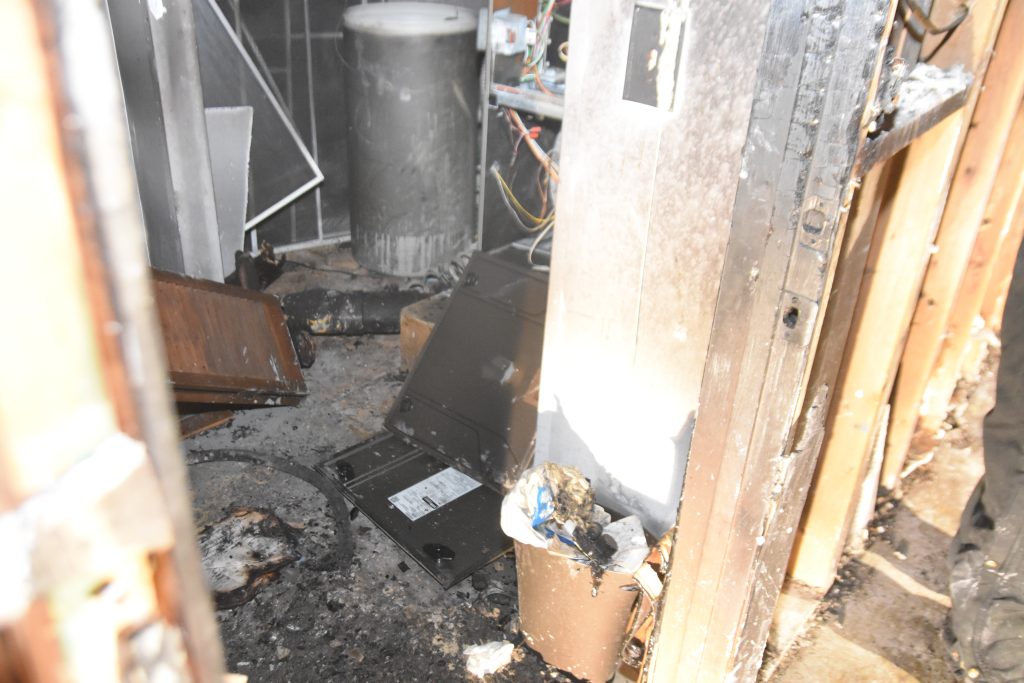
This is not the first time Officer Flavin has omitted the truth or even lied to enforce a narrative of suspicion. Officer Flavin later claimed in testimony that the homeowner’s son’s room lacked a mattress. This statement was also false, as witnesses present on the night of the fire, along with Officer Flavin’s own body camera footage, show the mattress. Additionally, photos taken the day after by Fire Marshal Jordan Zernick confirm its presence.
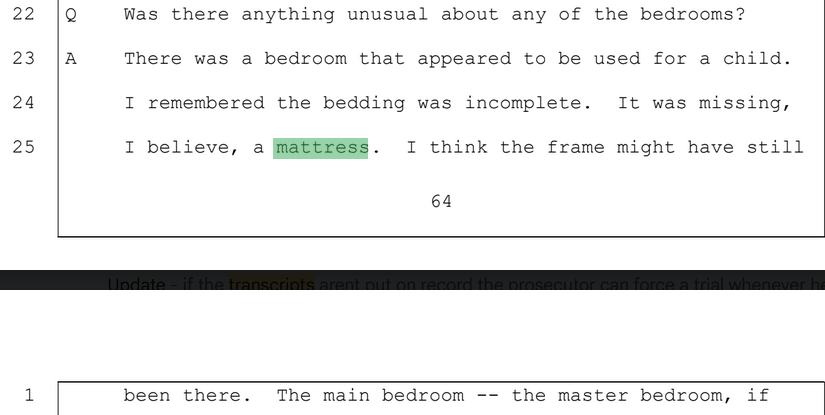
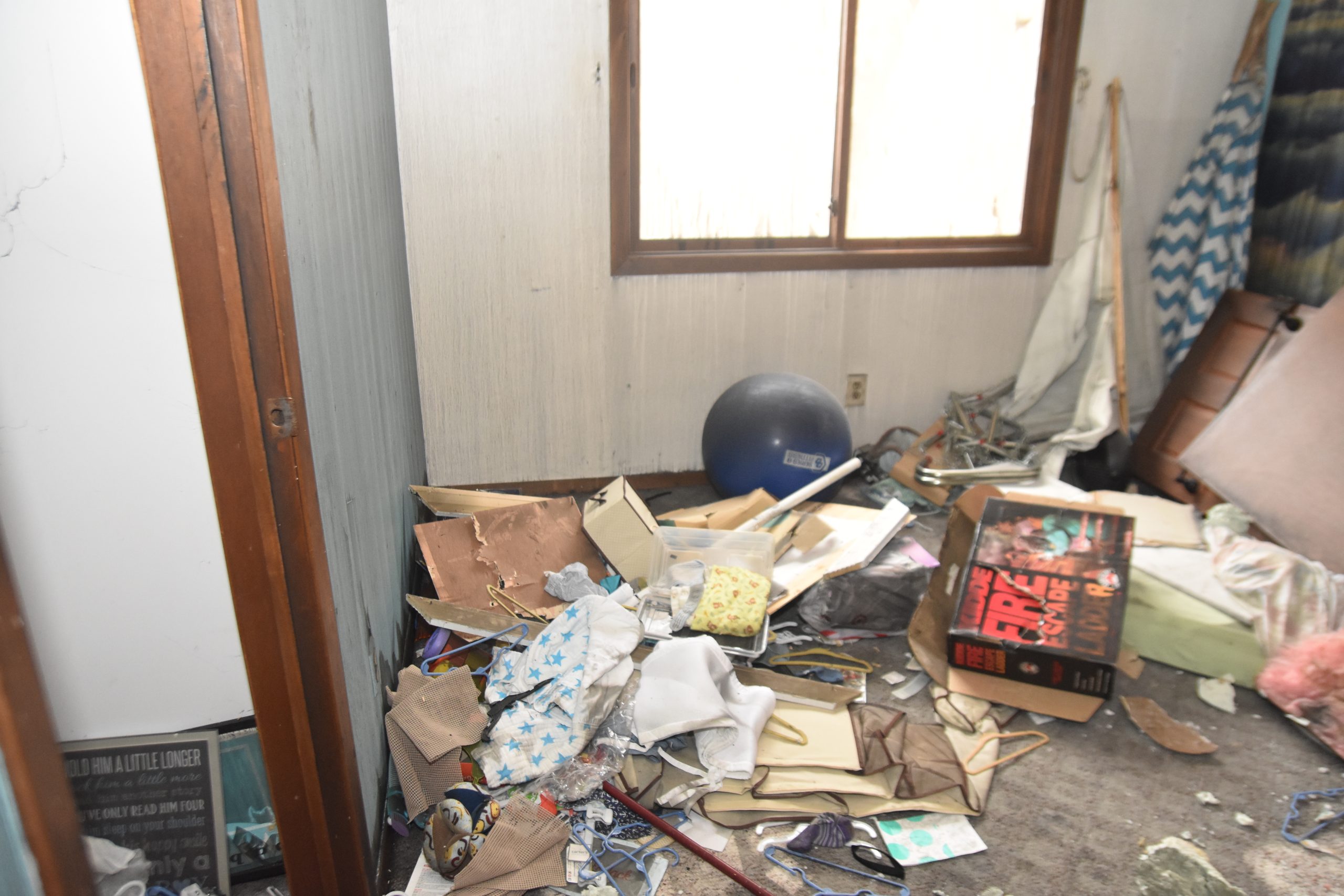
While we introduce just two narratives in Part 2, you can visit Part 1 to see the numerous instances of Hamburg’s forced narrative, as well as explore the evidence room for complete testimony and reports. These narratives are critical throughout the case against the homeowner and reveal a clear and intentional bias in the investigation.
In the next section, we will discuss the latest motion hearings, tabulation errors and the testimony from those proceedings, which will once again highlight the negative intentions of Hamburg Public Safety.
The homeowner, knowing there was clear evidence that a consent-to-search form was not signed on the day of the fire (November 19, 2019) or the following day, requested his attorney file a motion to challenge this. This motion, along with a motion to challenge the search warrant—based on Sergeant Harpe allegedly lying in his affidavit to obtain a magistrate’s approval—was heard on July 24, 2024, and July 31, 2024. Both motions were denied by a Livingston County judge. We encourage readers to read the full testimony as posted in the evidence room.
Regarding the search warrant, Sergeant Harpe admitted to some errors, though these were minor compared to what was actually stated in the affidavit. However, during testimony, when the homeowner’s lawyer attempted to challenge the search warrant, the prosecuting attorney objected on the grounds that the specific issues being argued in the affidavit were not outlined in the motion to quash. As a result, the judge prevented the homeowner’s lawyer from addressing the fact that Sergeant Harpe had made claims in his affidavit about the homeowner that were in question.


While the objection raised by the prosecutor identified an opening to prevent the homeowner from pursuing the lies within the affidavit, one of the more stunning events occurred when the judge made his final decisions on both motions and explained the reasons for denial. While the full context is lengthy (see transcripts), the judge cited one reason for not needing a consent form for the Fire Marshal to be inside the house for multiple days: exigent circumstances.
The judge referenced the Fire Marshal’s testimony, which stated that “the remains of the fire continued to smolder for numerous days, and the overhaul process took several days,” as justification for Hamburg to enter the home without a warrant or consent. This reasoning would make sense—if it were true.


While we believe nearly everyone would agree that if there is an active fire, the fire department should be able to enter a premise to extinguish it, the facts in this case tell a different story. Testimony from Part 1 reveals that the Fire Marshal himself stated the fire was out within minutes. Additionally, we know that the fire department left the scene around 5:30-6:00 PM the day of the fire, leaving only the police, Fire Marshal and Chief Miller. A boarding company was also contacted by the Fire Marshal to secure the residence. There was absolutely no fire smoldering for days inside the homeowner’s house, yet this claim was used as part of the judge’s decision to deny the motion.
One of the oddities during this hearing was that the actual testimony of the Fire Marshal contradicted what was stated by the judge. Not only is there previous testimony from other hearings confirming this, but in this hearing, the Fire Marshal directly stated that the smoldering had been extinguished on the day of the fire.

While the judge’s determination was shocking and hard to ignore, the motions revealed additional information through testimony that further supported the homeowner’s position, along with the allegations presented in Part 1. We will go deeper into testimony shortly.
Tabulation and Metadata
A search warrant was granted by the Magistrate Sherwood based on the affidavit by Sergeant Harpe. (However, the search warrant affidavit contained false information and errors, as noted in Part 1.)

Within the warrant, there are specific instructions regarding the warrant protocol, such as having a witness sign, returning a copy of the tabulation to the court, and, most significantly for our investigation, providing a general tabulation of the items seized from the homeowner.
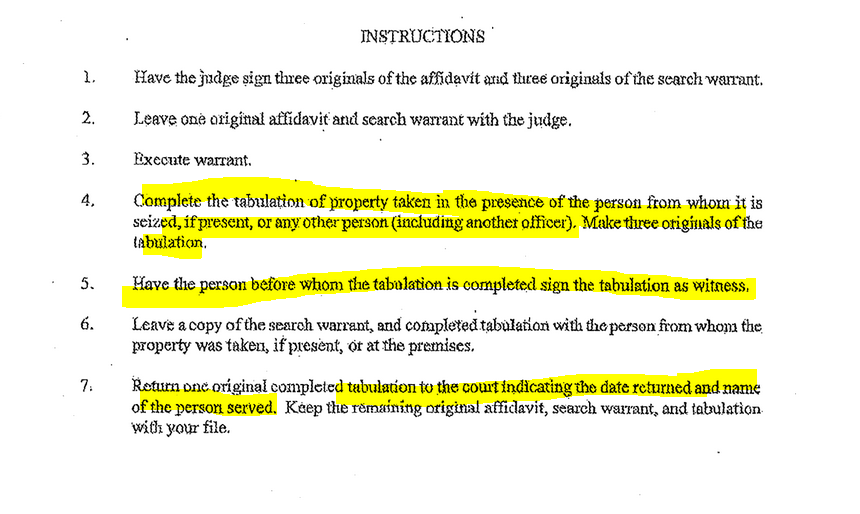
The warrant was approved and served on December 11th, 2019, according to the tabulation signed by Sergeant Harpe. This was 22 days after the fire occurred.

The homeowner found it odd that they waited so long to serve the warrant—after all, he was accused on November 27th 2019. He began examining the items they took and noticed something unusual about the tabulation. He observed that multiple inks were used in the document, fluctuating from black ink to blue, then back to black, and finally signed in blue.
At first, he suspected that different people had added items to the list. However, after conducting forensic analysis, he confirmed that the handwriting was from the same person. The letters A, E, and R were very distinctive throughout the analysis, resulting in a 99.98% match to the same individual.
Based on the blue handwritten signature, the homeowner suspected that the blue items in the tabulation were documented at the same time, and that the black ink items at the bottom were added at a different time. However the homeowner through his investigation wanted to know why and thought this was strange, that is when things took a bit of a turn.

Upon reviewing the police reports, the homeowner noticed that all the items were documented as being taken on the day of the fire, November 19th, 2019. As discussed in Part 1, there was nearly zero chain of custody, but the tabulated items were dated December 11th, 2019. The homeowner found this very strange and began to question whether the items were taken before the warrant was issued and then possibly covered up by creating tabulation data indicating they were taken after obtaining the warrant.
They had testified that the lamp was intact at a previous hearing, but this tabulation also shows that the lamp base was removed on December 11th, 2019—the day the warrant was signed. The homeowner concluded that possible misconduct occurred, and considering how many other things the Hamburg Fire Investigation team allegedly did wrong, this would not be surprising. His next step is to gather further evidence to support his claims that there may have been manipulation by the very people we are supposed to trust.
If this was not proof enough, the homeowner figured there would be photos of the items in his house that the Fire Marshal would have taken as part of proper procedure before removing them. These pictures would hold key evidence—not only showing the items within the house but also containing hidden metadata digitally embedded in the photos, which could uncover a more detailed picture.
He needed a way to obtain these photos, as they were never provided during the discovery process. In fact, the discovery photos were arranged in a way that made retrieving metadata nearly impossible. The homeowner knew, through his training and experience, that these images had to exist in their original form. He requested them through a FOIA (Freedom of Information Act) request, and the analysis would show exactly what he suspected. While the homeowner ran forensics on all photographs obtained here are three that illustrate the suspicions.
The floor samples listed on the tabulation sheet are claimed to have been taken on December 11th, 2019, but metadata shows the floor samples were still within the house on December 16th, 2019.

The lamp base listed on the tabulation sheet is claimed to have been taken on December 11th, 2019, but metadata shows the lamp base was still within the house on December 16th, 2019.
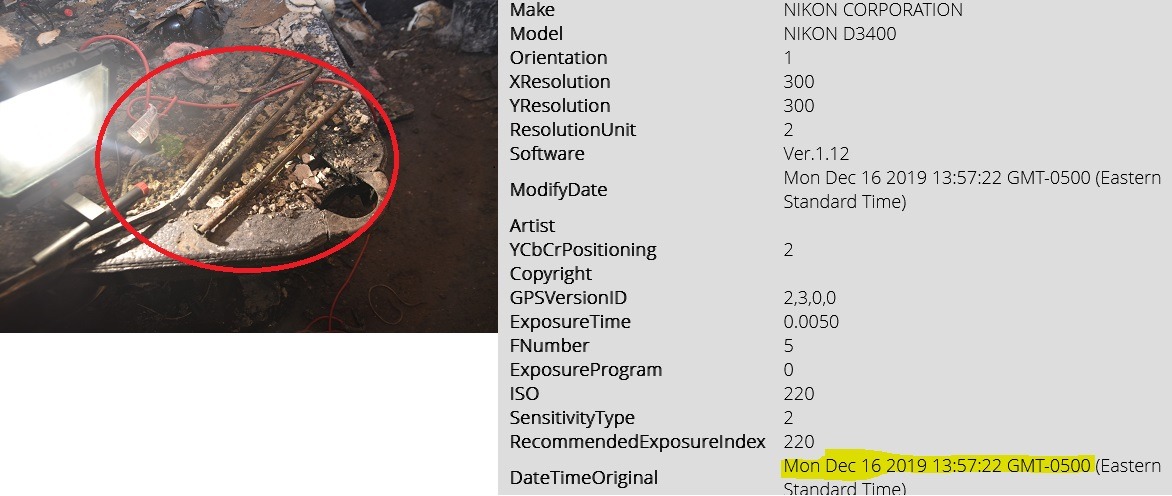
The basement bathroom smoke detector listed on the tabulation sheet is claimed to have been taken on December 11th, 2019, but metadata shows the basement bathroom smoke detector was still within the house on December 16th, 2019.

The forensic analysis of the photographs reveals some serious conflicting data, raising many questions about what actually happened. Were the items removed on the day of the fire, as suggested in the police report? Were they added to the tabulation to cover for their removal without a warrant? Were they brought back on December 16th so photos could be taken?
Once again, these photos were not provided during discovery—is it because someone knew that things wouldn’t add up? One thing is clear and that is the homeowner uncovered more malfeasance. We will delve into the latest hearing from July 2024 to possibly uncover more information on this later in our report.
Floor Sample Analysis and Lab Results
It is no coincidence that we used a floor sample as an example earlier (see above). You may be wondering about the results. While we initially received partial results from a discovery file, we were able to obtain the full lab analysis from the Michigan State Police that was not included in the discovery file.
In Part 1, we discussed that an accelerant detection canine was brought into Mr. Neumeier’s home and did not alert to any accelerants. This inspection allegedly took place the day after the fire. However, it was nearly 28 days later that the fire investigation team collected samples of the flooring for laboratory testing. According to NFPA 921 guidelines, such a delay is problematic. The number of people entering and exiting the house was not logged, and testimonies vary regarding who was present and when. This is significant because contaminants from individuals’ footwear could compromise the integrity of the scene and the samples collected.
Regarding the lab results:
- Two of the three samples tested showed no ignitable liquids
- One sample, which was the comparison sample, indicated the presence of a medium aromatic. (Insecticide)
These findings raise concerns about the potential for scene contamination and the reliability of the evidence collected after such a prolonged period and lack of scene security.


The homeowner informed investigators that he had camping equipment stored in the affected area and mentioned the possibility that bug spray was present during his interview. This was later substantiated by the fire marshal’s photographs, which showed bug spray cans within the rubble.



While the presence of insecticide was not noted in any Hamburg report, another significant issue emerged regarding the handling of the collected samples. It was discovered that the samples were submitted without proper tagging to indicate the specific locations from which they were taken. This procedural oversight was noted by the laboratory in a report that was not provided during the discovery process.
The absence of detailed location information for the samples violates standard investigative protocols and can compromise the validity of the laboratory results. Proper tagging and documentation are crucial for establishing a clear chain of custody and ensuring the reliability of the evidence. This omission raises concerns about the thoroughness of the investigation and the potential impact on the case’s outcome.

The homeowner stated that “no investigator examined the cans of bug spray; they should have been taken into evidence and evaluated for any punctures or leaks. After hearing testimony about how the fire marshal and the insurance investigators were on their hands and knees in the origin area, it is likely that residue from the bug spray came into contact with them. This is of course if we assume sample 3 was near the origin. Sergeant Harpe didn’t label the locations of anything so it would be a guess based on the fire marshal’s photos.”
Since the medium aromatic —most likely originating from bug spray—was found only in the comparison sample, it can be safely assumed that the bug spray did not contaminate floor samples 1 or 2. This along with the accelerant canine dog would point to the homeowner being vindicated to any original testimony of a “accelerant pour pattern” being on the floor. State Police lab reports debunk Hamburg’s theory but it was without one last shot by Sergeant Harpe showing his biased nature through the lab test before he even got the results.

By stating that there was an accelerant pour pattern before receiving the lab results, Sergeant Harpe appeared to assume arson without definitive evidence of any accelerant. This approach may indicate a bias, as a trained investigator following NFPA 921 guidelines should submit samples without preconceived notions or assumptions about the outcome. A thorough and unbiased investigation requires waiting for empirical data before drawing conclusions.
In this case, the lab results did not detect any identifiable accelerant in the samples taken from the areas of origin. This suggests that the initial assessment of an accelerant pour pattern was incorrect. Such premature conclusions can impact the integrity of the investigation and highlight the importance of adhering strictly to investigative protocols to ensure accurate and reliable results.
Issues with Flooring Identification and Sample Comparison
In the report, it is noted that the flooring is described as a “veneer wood floor.” This is interesting because the floor in the area of the basement where the suspected points of origin were located was actually epoxy, not veneer wood. Therefore, using any other type of flooring as a control comparison would not be appropriate.
In fact, if the laminated wood portion of the basement was used as a comparison sample, it could cause significant issues. The dissimilarity between the epoxy floor at the origin points and the laminated wood elsewhere means that the materials would behave differently under fire conditions. This discrepancy could affect the validity of the analysis, leading to inaccurate conclusions.
Moreover, using different flooring materials introduces variables related to pyrolysis, the thermal decomposition of materials at elevated temperatures. Since epoxy and wood laminate undergo pyrolysis differently, any findings based on such comparisons would be unreliable. It’s crucial for the integrity of the investigation that control samples match the materials present at the suspected origin points to ensure accurate and meaningful results.

Homeowner’s Note on Lab Analysis and Bug Spray
It is important to state that bug spray and insecticide are different but similar in that many bug sprays use solvents, propellants, or carriers—some of which are aromatic hydrocarbons or other compounds in the C8 to C11 range. This aligns with the lab analysis findings.
While the presence of bug spray in the area makes sense, given that cans were visible in the storage area, it should also be noted that this storage space included other items from my previous businesses. The lab report showing eluted C8–C11 compounds could be attributed to various sources, stemming from pyrolysis or even essential oils.
It’s also important to note that the comparison sample of veneer wood suggests that the floor samples were not taken from under the stairs or in front of the storage closet. The samples taken from the suspected origins showed no ignitable liquids. This indicates that in the area where a pour pattern was claimed, there were no accelerants present.
The following is an analysis of the motion hearings from July 2024, based on transcripts.
The following testimony pertains to two motions brought before the court by the defendant: one regarding the alleged falsehoods used to obtain a search warrant, and the other concerning the improper creation or use of a consent form.
Officer Kim Leeds - Testimony
We will begin with the first witness, Officer Kim Leeds. Her signature was listed under the witness section of the consent-to-search form. As covered in Part 1, this consent form has been a topic of scrutiny, as it was dated the day of the fire, November 19, 2019, making it impossible for Officer Leeds to have signed it on that date. As we are about to uncover, the homeowner was correct—Officer Leeds tells the truth under oath, however it is very conflicting with the narrative set by Hamburg Public Safety. Here is testimony from Wednesday, July 24, 2024 by Officer Kim Leeds


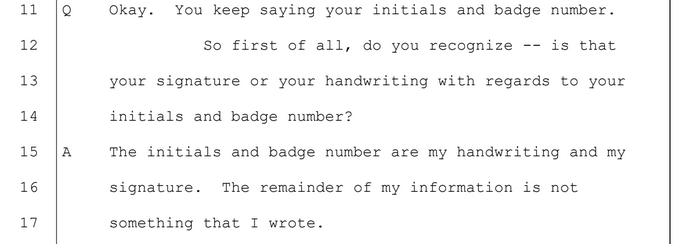

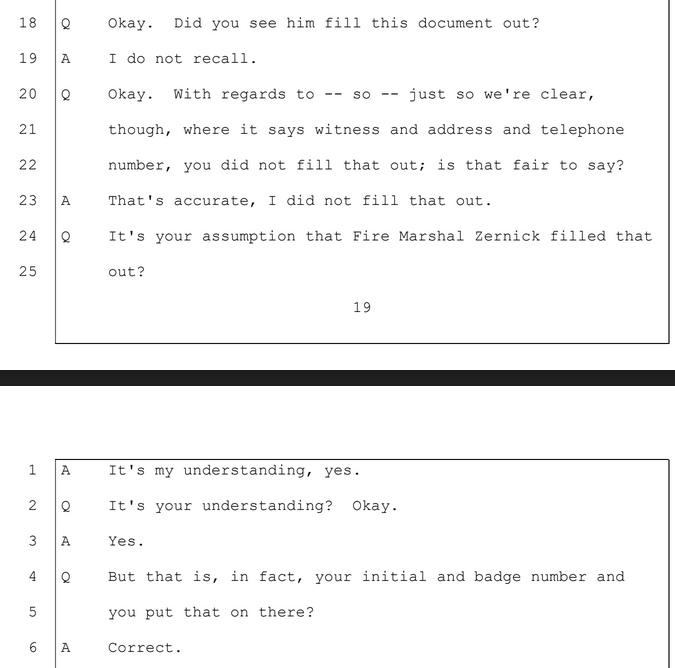

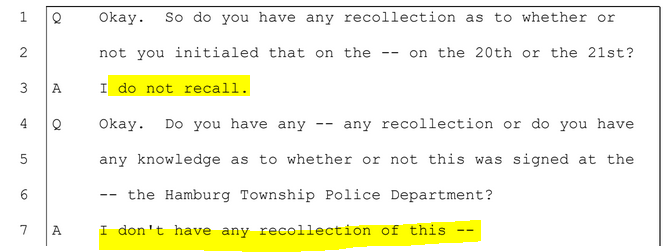

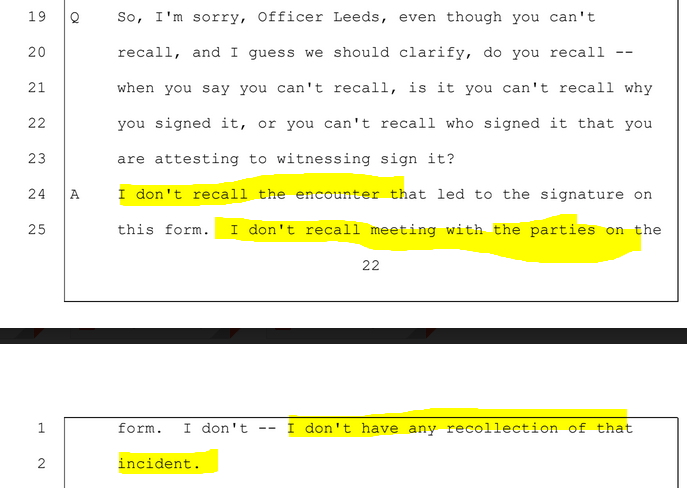

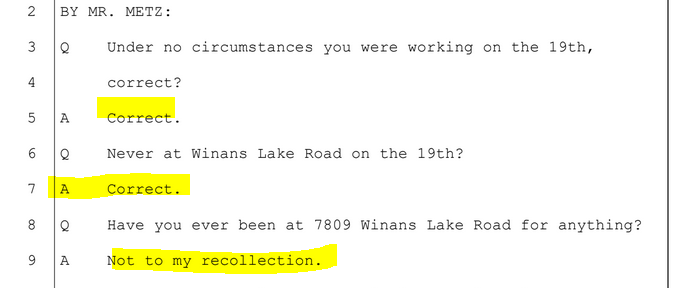

Fire Marshal Jordan Zernick - Testimony
It is important to note that the prosecution aimed to prove that exigent circumstances existed, allowing the Fire Marshal unfettered access to the home without violating the Fourth Amendment. From Part 1, we know that the fire was extinguished on the night it occurred, with the fire department leaving around 5:30 PM, after which the investigation into the cause and origin began. While exigent circumstances did not truly exist, let’s look into how the narrative was presented to suggest otherwise.
Fire Marshal Jordan Zernick began by stating that there were visible areas of smoldering from the exterior of the home on the day of the fire.

Fire Marshal Jordan Zernick testified that he would be the only person with access to the residence. However, we know this statement is not supported by the facts, as he allowed multiple people into the house during his investigation, including both government officials and members of the public. For detailed information on who he permitted inside, please refer to Part 1.
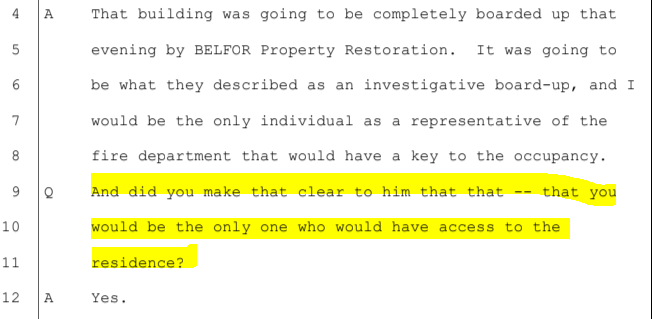
Fire Marshal Jordan Zernick testified that on the day of the fire, he did not anticipate it would become a criminal investigation. However, this response is under scrutiny. He contacted a boarding company for an investigational lock-up and assumed the fire was suspicious due to specific “origin points” he identified. That same evening, he informed Sergeant Harpe about the suspicious nature of the fire and reached out to Officer Flavin on his day off to assist with the investigation. It’s important to note that in later testimony, it was verified that Sergeant Harpe’s involvement in this investigation was of a criminal nature..

Fire Marshal Jordan Zernick testified that the homeowner provided specific locations of his computer. This is important legally because granting access to retrieve a specific item from a specific location does not authorize a full search of the entire property

Fire Marshal Jordan Zernick testified that he regretted his decision to allow the homeowner access to his computer.
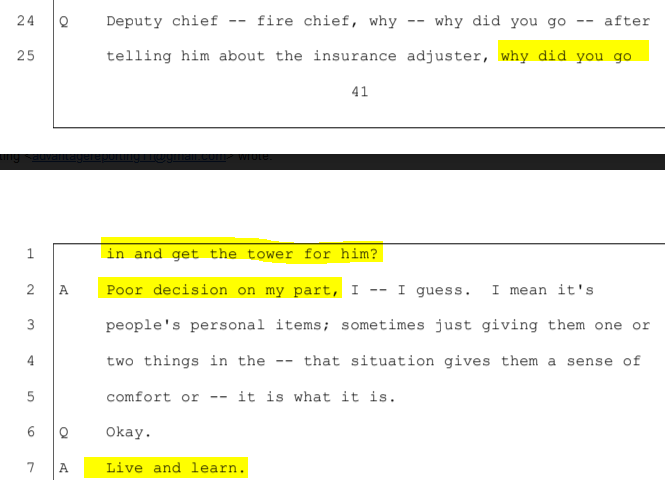
Fire Marshal Jordan Zernick testified that the homeowner provided the specific location of the DVR. This is important from a legal standpoint because granting access to retrieve a specific item from a specific location does not authorize a full search of the entire property.

Fire Marshal Jordan Zernick would confirm the location of the DVR.

Fire Marshal Jordan Zernick confirmed that he collected the DVR and handed it over to Sergeant Harpe the following day. This establishes that Sergeant Harpe had possession of the DVR the day after the fire.

Fire Marshal Jordan Zernick testified that he did not have a consent-to-search form in his truck but still made attempts to have the homeowner sign one.
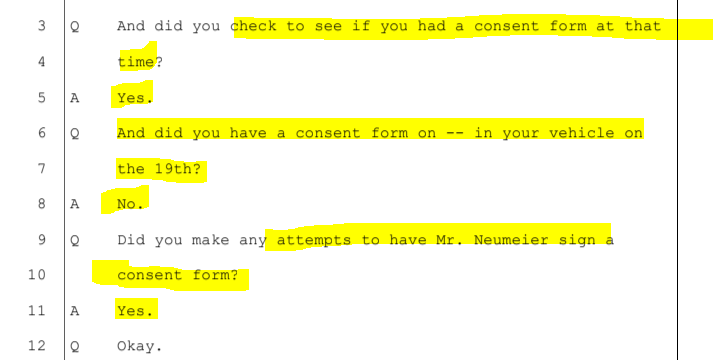
We know that the following day was November 20th. According to video evidence from the previous night, the homeowner was unable to meet with the Fire Marshal, and there was no discussion about signing a consent form captured in the footage. The next day, a member of Public Safety contacted the homeowner and left a voicemail stating that the Fire Marshal would not be meeting with him, and there was no reference to any consent form mentioned in this voicemail. (See Part 1)
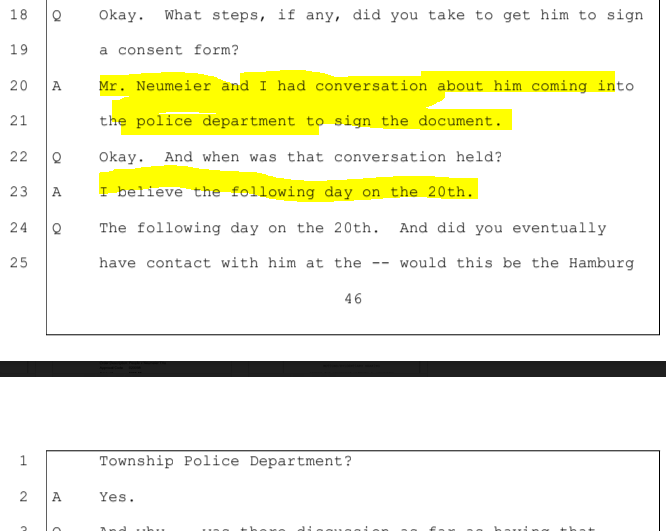
Fire Marshal Jordan Zernick mentioned that he wanted the consent form to be signed at the police department so that it would be captured on camera.
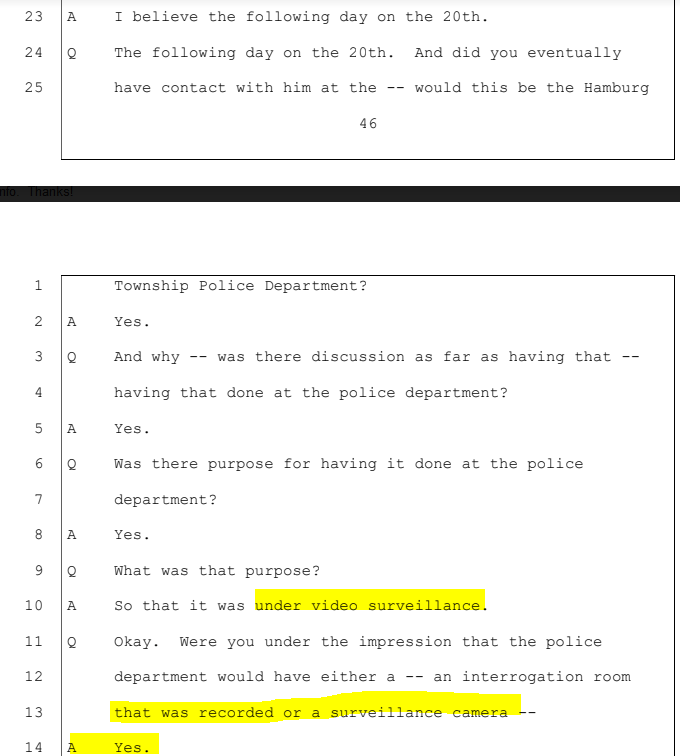
Fire Marshal Jordan Zernick testified that he did not know whether the consent form was signed on the 20th or the 21st. However, when led by the prosecutor, he recalled it being signed the day after the fire. This makes little sense, as the homeowner was unable to meet with the Fire Marshal on that day, and the department had stated that no meeting would take place (Part 1 Voicemail).
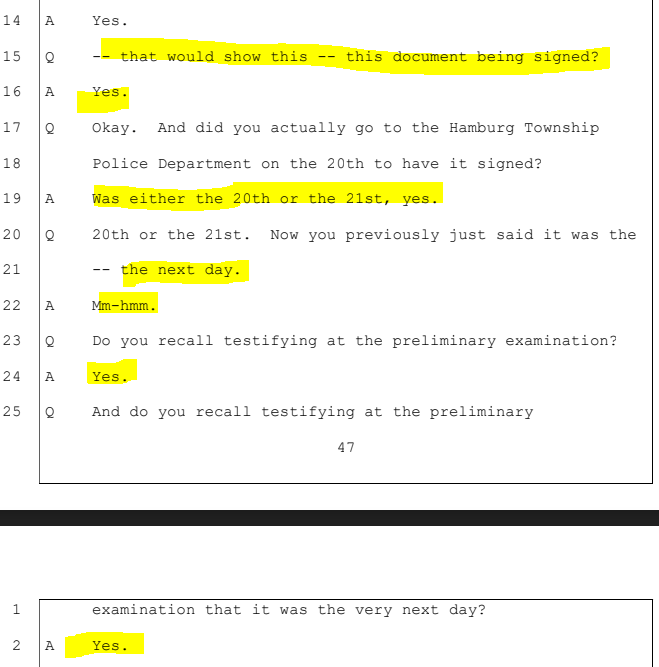
Once again, the prosecutor attempted to lead Fire Marshal Jordan Zernick’s testimony, but the Fire Marshal remains uncertain about the specifics.

Fire Marshal Jordan Zernick testified that he filled out the consent form on the evening of the fire. However, this statement raises further questions. This discrepancy calls into question the timing and validity of the consent form, highlighting potential irregularities in the investigation process.

Fire Marshal Jordan Zernick admitted that he completed the entire consent form except for a signature. This supports the homeowner’s claim that the form was never filled out by any witness, specifically Kim Leeds, undermining the legitimacy of the consent process.
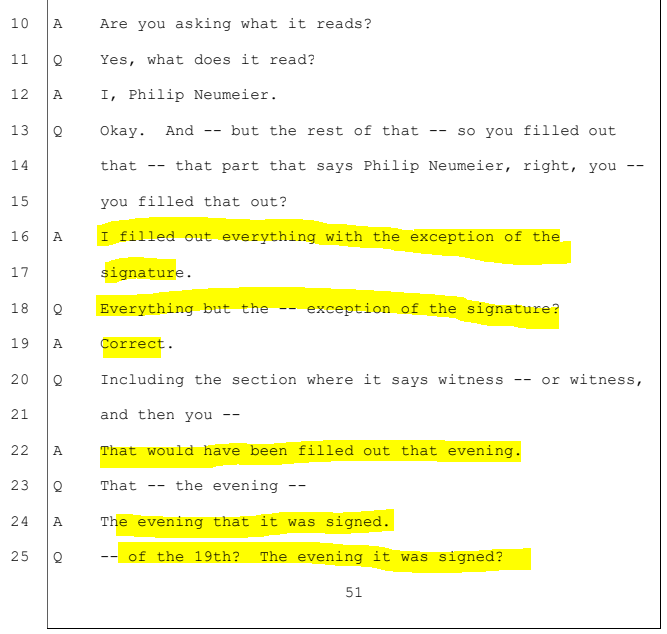
Fire Marshal Jordan Zernick elaborated that he completed the entire consent form except for the witness’s signature, including the homeowner’s information. He left only the witness’s signature blank. This supports the homeowner’s claim that the form was never filled out by him or any witness, specifically Kim Leeds, thereby undermining the legitimacy of the consent process.
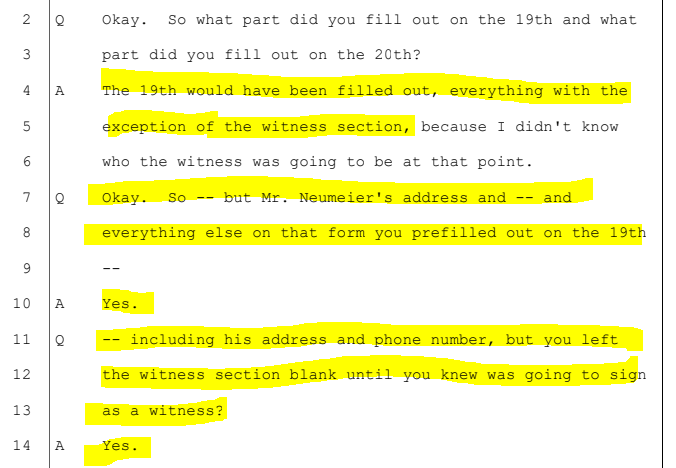
The prosecutor once again attempted to lead Fire Marshal Jordan Zernick into stating that the consent form was signed on the 20th, but the Fire Marshal could not recall. However, he stated that he witnessed the homeowner sign the document. At the same time, earlier in the questioning, he had already confirmed that he completed everything on the form except for Kim Leeds’ signature.

Fire Marshal Jordan Zernick testified that he left the scene “as was” and waited until the insurance investigator arrived to conduct their investigation, ensuring that both parties would be examining the same aspects. However, we know this to be false. In Part 1, it is clearly demonstrated that the chair from the assumed origin point was moved before the insurance investigator was on site. Additionally, Officer Flavin’s police report states that items were relocated from the origin point prior to the insurance investigator’s arrival. Furthermore, the Fire Marshal from the neighboring city claimed he was present on the day of the fire to move debris. These statements directly contradict Fire Marshal Zernick’s testimony.
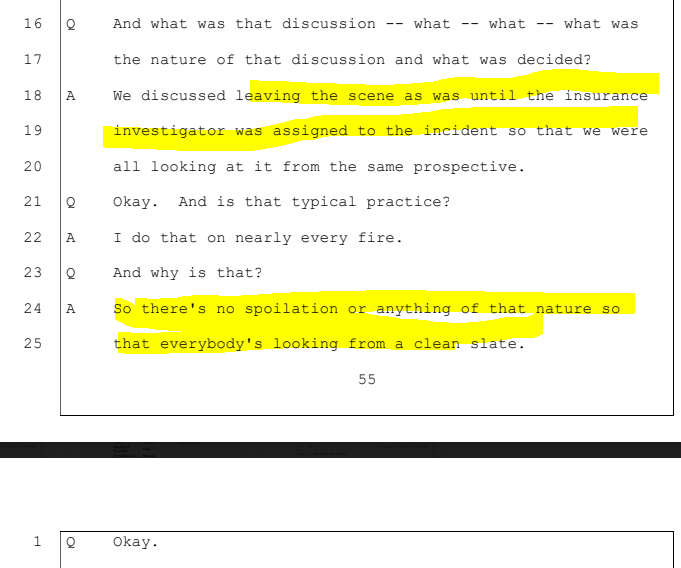
Fire Marshal Jordan Zernick stated that the house was secure. However, this is not accurate, as the boarding company, as demonstrated in Part 1, left the basement door unsecured. The term “secure” does not accurately describe the entire house, and specifically does not apply to the basement area.

This is a prime example of the prosecutor leading the witness to solicit specific testimony. We understand the intention behind this approach, but throughout the testimony, the prosecutor attempts to correct the witness’s statements.
In this example, the prosecutor asks Fire Marshal Zernick a compound question: “Did the police have access, or was it solely you?” The Fire Marshal responds, “Solely me.” Immediately after, the prosecutor follows up with, “Would they have access through you?”
This line of compound questioning is not crucial, as we have already established in Part 1 that the Fire Marshal was not the only person with access to the property. However, he is indeed the only person with a key to the single padlock on the garage.
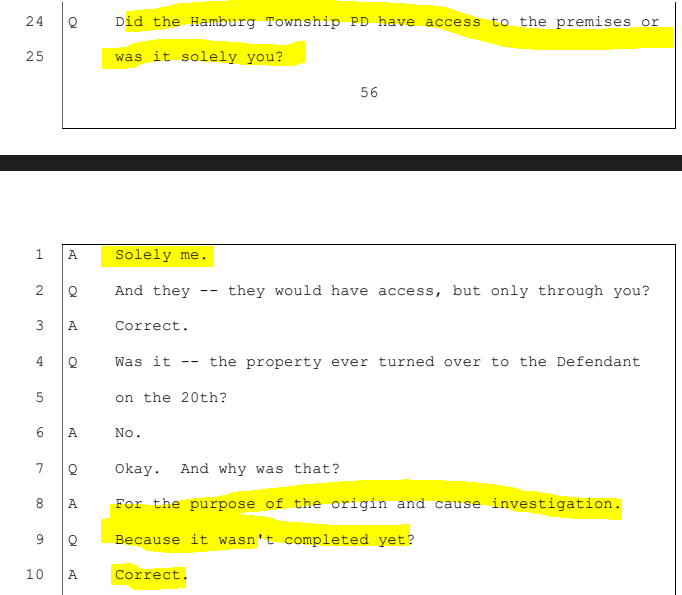
Fire Marshal Jordan Zernick was asked during his investigation whether the insurance investigator was separate from his team. However, as demonstrated in Part 1, they did indeed work together. Through correspondence via email and interviews, it is clear that they collaborated closely. Additionally, logs show Investigator Berard stating that Hamburg informed him a crime had occurred and that the homeowner was a suspect. Conversely, Berard informed the Fire Marshal that the supposed incendiary device was indeed an incendiary device.
There are multiple instances of their collaboration. For example, Sergeant Harpe testified that he invited the insurance investigator to the Hamburg Police Department so they could review video footage together. Evidence indicates that they did collaborate, undermining the Fire Marshal’s testimony and revealing a bias in the investigation.
This collaboration contradicts the Fire Marshal’s claims of independence and suggests a coordinated effort to influence the investigation’s outcome. Such actions raise serious concerns about the integrity and objectivity of the investigative process conducted by Hamburg Public Safety.
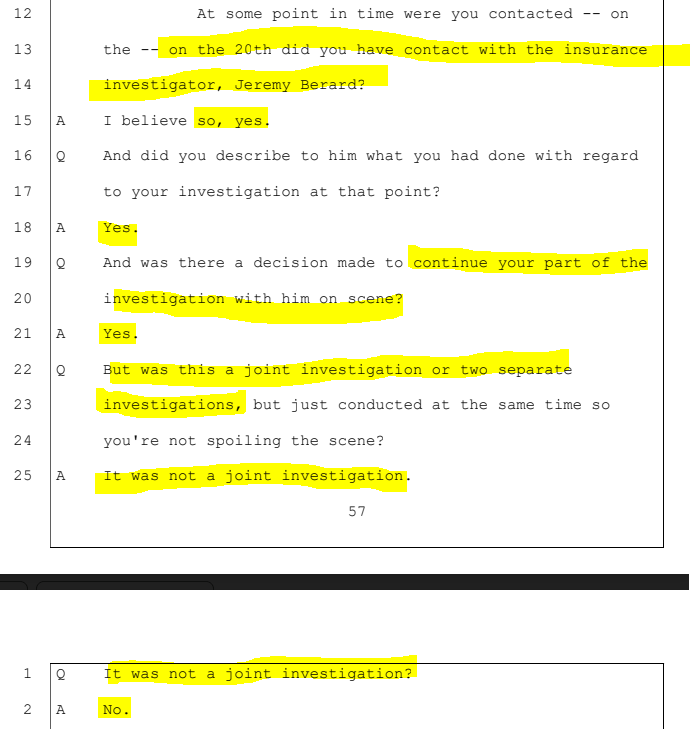
Fire Marshal Jordan Zernick stated that he did not make a determination because the insurance investigator discussed hiring an electrical engineer. This raises the question: if the insurance investigator had not been present, would a determination have been made?
Furthermore, the Fire Marshal mentioned that the investigation was stopped, which leads to another question: if they were not supposedly working together, why would the government allow a member of the public to influence the progression of the investigation?
These contradictions suggest a deeper issue within the investigative process and call into question the integrity and objectivity of Hamburg Public Safety’s handling of the case.
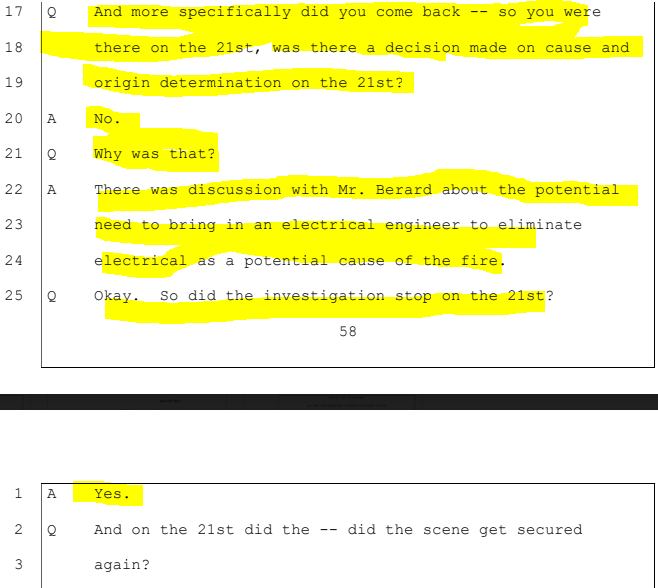
Fire Marshal Jordan Zernick admitted to reviewing the video surveillance with the insurance investigator at the police station. He also acknowledged that evidence was gathered from this video footage. This raises the question: evidence of what? and at this point just days into the investigation they are suggesting they didn’t work together.
Earlier in his testimony, he claimed that he did not suspect a crime. However, now he has retrieved evidence, which appears contradictory. It is important to note that there is zero video footage showing the homeowner conducting any criminal misconduct. Mr. Neumeier has maintained his innocence throughout the entire investigation and beyond.
These contradictions further support the homeowner’s assertion of innocence and raise serious concerns about the integrity of the investigation conducted by Hamburg Public Safety.
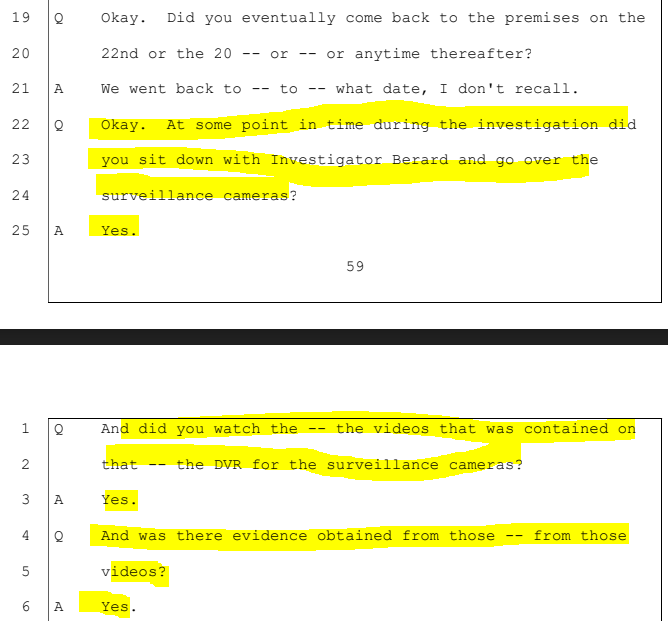
In later testimony, Fire Marshal Jordan Zernick stated, “We,” referring to himself and the insurance investigator, found a possible incendiary device. When questioned about the possibility of the fire being accidental, the Fire Marshal became vague and mentioned it as a potential cause. This ties back to Part 1, where we discovered that no testing was conducted on the supposed incendiary device. The reason it was labeled as such was solely because the insurance investigator informed the Fire Marshal of its nature.
This raises the question: if the Fire Marshal and the insurance investigator were not working together, would the Fire Marshal have proposed a different hypothesis? We do not know for certain. However, it is evident that there was no scene recreation performed with the supposed device, nor did Hamburg Public Safety test whether it was even possible for it to function as an incendiary device.
Furthermore, the homeowner elaborates in Part 1 on testing that disproves the theory of an incendiary device being the cause of the fire. These inconsistencies highlight significant flaws in the investigation process and suggest a possible bias or coordination between the Fire Marshal and the insurance investigator that undermines the credibility of the findings.
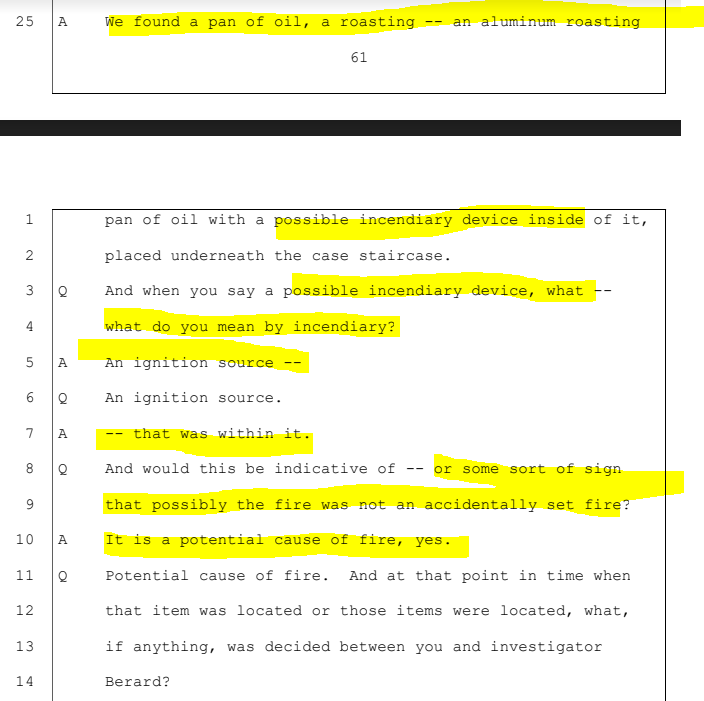
To further support the fact that Hamburg was indeed working with the insurance investigator at certain times, we can examine Fire Marshal Jordan Zernick’s own testimony. He cites statements such as “We removed the device,” “We systematically removed the items,” and “We seized everything.” Additionally, Fire Marshal Zernick confirms that Sergeant Harpe’s role in the investigation is on the criminal side.
Recall that in previous testimony, Zernick claimed he suspected a suspicious fire but did not categorize it as criminal. However, on the night of the fire, the Fire Marshal reached out to Sergeant Harpe—the very individual he testified was involved in criminal investigations. In Part 1, we know that Sergeant Harpe wrote, “On November 19th, 2019, I was contacted to assist the Hamburg Township Fire Department with a cause and origin investigation for a suspicious residential structure fire located at 7809 Winans Lake Rd.” This establishes that the Fire Marshal did consider the need for a criminal investigation, contradicting his earlier statements.
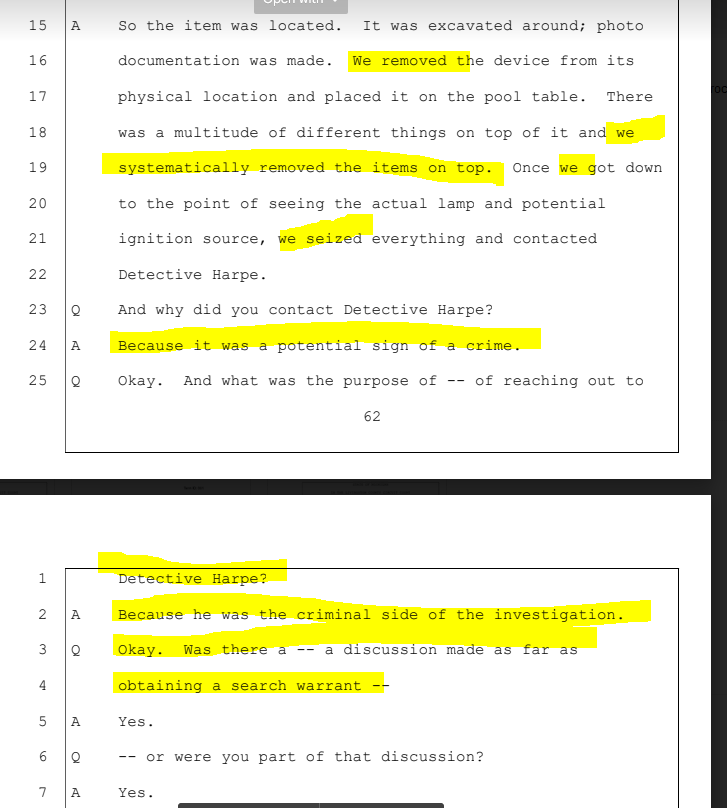
Fire Marshal Jordan Zernick reinforced Sergeant Harpe’s role in the investigation but also stated that on November 27, the investigation was shut down until a search warrant was obtained. This search warrant was not secured for over two weeks. The Fire Marshal implied that the investigation had ceased and that no one was present at the homeowner’s house during those two weeks. However, witness accounts contradict this assertion. The homeowner had trail cameras set up on his driveway, from which the Fire Marshal removed memory cards without reporting them. This issue will be discussed further in Part 3.

Fire Marshal Jordan Zernick admitted to having a conversation about the consent form with Officer Flavin, but he also confirmed that he did not discuss the consent form with the homeowner. This contradicts his earlier testimony, where he claimed that a meeting was set up for the consent form to be signed as well as attempts being made to get the homeowner to sign the consent.

Fire Marshal Jordan Zernick continued to contradict himself during his testimony. Two days before this testimony, he acknowledged reviewing video footage from the night of the fire, during which he requested contact with the homeowner without mentioning the purpose of a consent form. As he proceeded with his testimony, it became increasingly clear that the claim of having a consent form signed on the night of November 19th or the following day, November 20th, was fabricated. This inconsistency undermines the credibility of his statements and supports the homeowner’s assertion that the consent process was never properly conducted.
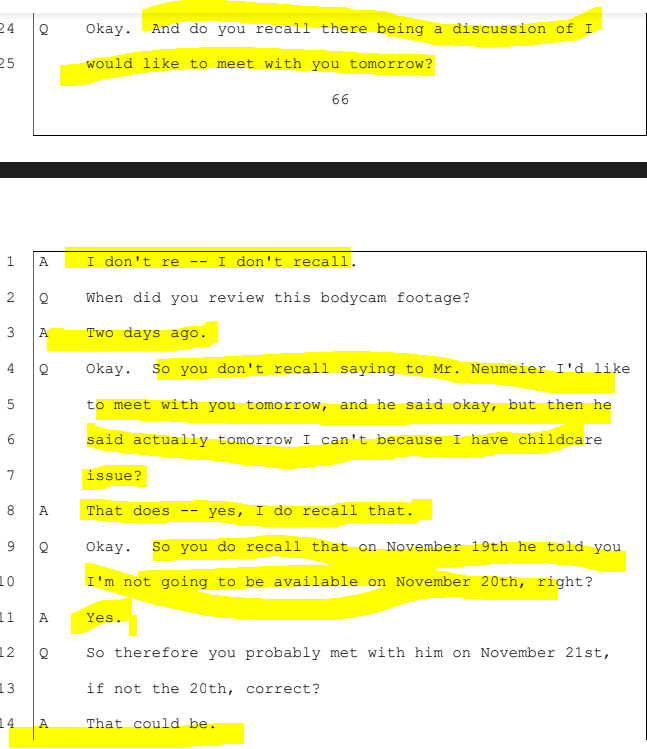
The defense attorney successfully questioned Fire Marshal Jordan Zernick when Jordan extended his testimony to include November 21st as a possible date for meeting with the homeowner. This encounter was allegedly held at the police station, as detailed in Part 1, where Hamburg Public Safety mysteriously lost the footage of the event. In his testimony, Fire Marshal Zernick explained that the reason for conducting the meeting at the police station was to ensure it could be recorded.
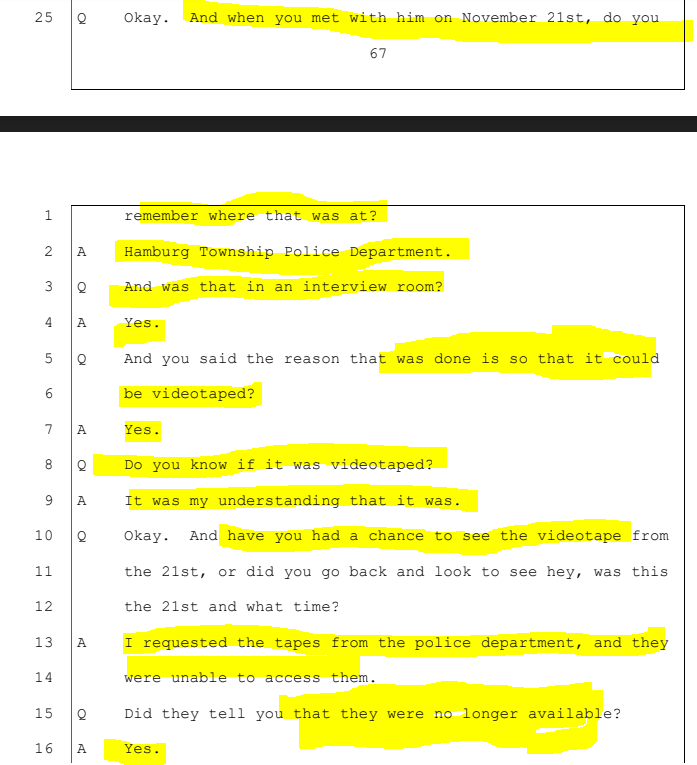
Fire Marshal Jordan Zernick once again testified that the fire was extinguished on the day of the incident and that it was put out relatively quickly. However, this statement conflicts with the testimony the judge used to deny the homeowner’s motion. In his ruling, the judge stated that exigent circumstances existed, allowing firefighters to enter the property for several days.
This contradiction raises serious questions about the consistency and reliability of the testimonies. If the fire was indeed out quickly, as the Fire Marshal claims, then the justification for prolonged access under exigent circumstances becomes questionable. Conversely, if exigent circumstances were present, as the judge asserted, it suggests that the fire was not fully extinguished as initially stated.
These conflicting accounts undermine the credibility of the investigation and the rationale behind the judge’s decision to deny the motion. It is crucial to further examine these inconsistencies to ensure a fair and unbiased resolution to the case. ( At this time the homeowner is under the impression that this oversight was due to bad testimony and not meant to be a statement of fact by the judge and will give the judge the opportunity to review)
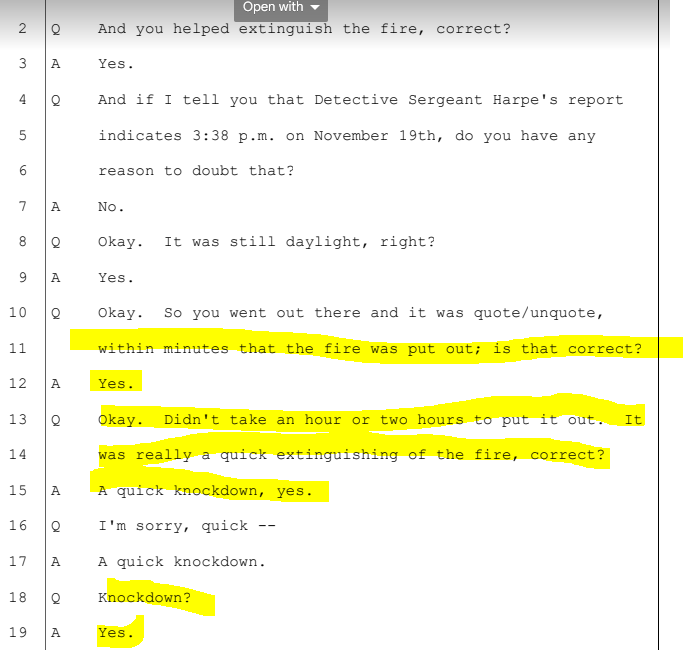
Fire Marshal Jordan Zernick continued his testimony, admitting that during his encounter with the homeowner, he did not ask for consent to enter the house. He proceeded to discuss origin points and the suspicious nature of the fire but did not classify it as criminal in nature, despite previous testimony referring to Sergeant Harpe as the criminal investigator being contacted that evening.
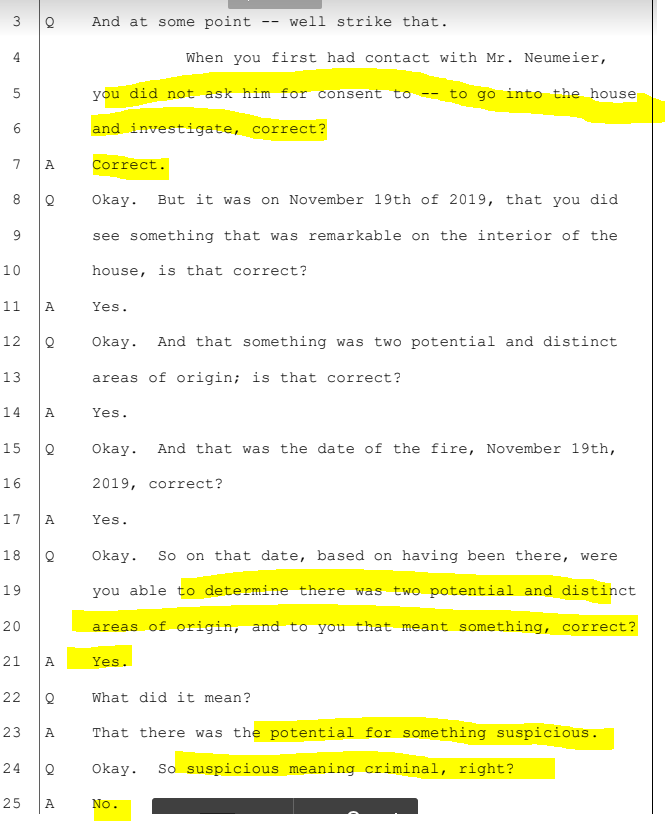
Fire Marshal Jordan Zernick stated that his preference was to obtain a consent form but did not do so. He claimed that obtaining consent forms is standard practice. This reinforces the homeowner’s claim that he knowingly did not secure a consent form, despite it being a matter of standard procedure. This would be one of the many times following NFPA 921 would have been beneficial.
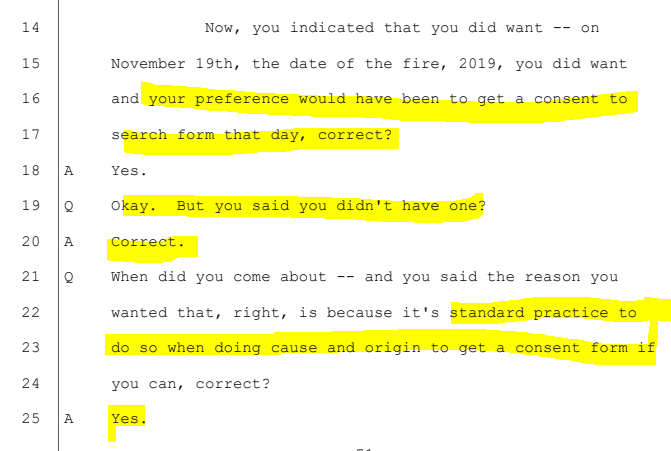
Further supporting the homeowner’s assertion that no consent was signed the day of the fire, the defense attorney presented a line from the alleged consent form stating voluntary consent without threat or promise dated November 19th. Fire Marshal Jordan Zernick had to admit that this did not occur.

The next line of questioning resulted in Fire Marshal Jordan Zernick admitting that not only was consent not signed on the day of the fire or the day after, but even if it had been signed, it could not have occurred until at least Officer Leeds was on duty, which was no earlier than 6 PM, 3 days after the fire.
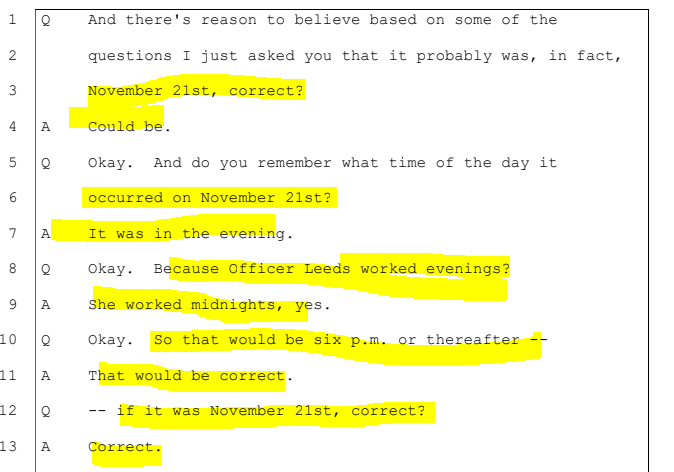
Fire Marshal Jordan Zernick is now compelled to address his actions by admitting that on November 19th, 20th, and 21st, he entered the homeowner’s house without a search warrant or valid consent.

Nevertheless, he contradicted his previous testimony in Part 1, where he claimed that after extinguishing the fire, he entered investigative mode. This time, the Fire Marshal stated that he was involved in the overhaul process after the fire was out, directly challenging his earlier statements. We know that on November 19th he contacted Officer Flavin to assist him in the cause and origin investigation. Officer Flavin arrived at the house around 5:30pm. We know that around 5:30pm-6:00pm the fire departments left he scene. According to the reports and body camera footage the only fire fighter present would have been the Marshal and Chief.
Part 2 is not intended to compare all testimonies at once but focuses specifically on this hearing. It is crucial to document this matter, as the prosecution is attempting to establish a case for the legal entry into the homeowner’s house by the fire department under the threat of an active fire which is simply not true.
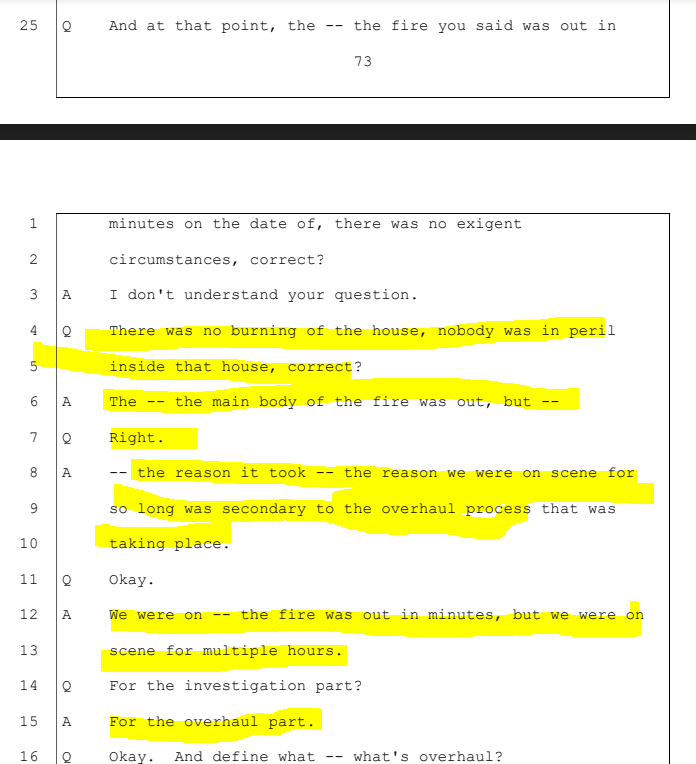
Fire Marshal Jordan Zernick claimed that firefighters were present on the scene when the homeowner arrived back at his house on the evening of the fire, and that this was captured on body camera footage. However, there is no report indicating that any firefighters from the fire department were performing overhaul duties at the time the homeowner was allowed access to his driveway. According to the records, the Fire Marshal was outside speaking with the homeowner, and at no point in the footage is the Fire Marshal seen performing any overhaul tasks.
According to Chief Miller’s narrative, the Fire Marshal’s duties transitioned from extinguishing the fire to investigating its cause and origin when Officer Flavin arrived around 5:30 PM. Furthermore, the report lists the firefighters who performed the overhaul duties, indicating that they cleared the space around 6:00 PM.
We do not want to delve into Chief Nick Miller’s role at this time, as he is only briefly mentioned in the reports, although he was present on the scene and is seen in Officer Flavin’s body camera footage. The overhaul function of Fire Marshal Jordan Zernick had concluded by the time the homeowner arrived, as evidenced by body camera footage showing the Fire Marshal searching through the homeowner’s personal items—an activity not typically associated with overhaul duties.
These actions further highlight the inconsistencies in the Fire Marshal’s testimony and raise questions about the true nature of the investigation. The absence of reports detailing firefighter involvement in the overhaul process, combined with footage showing inappropriate searching of personal items, suggests a potential deviation from standard investigative protocols by Hamburg Public Safety.
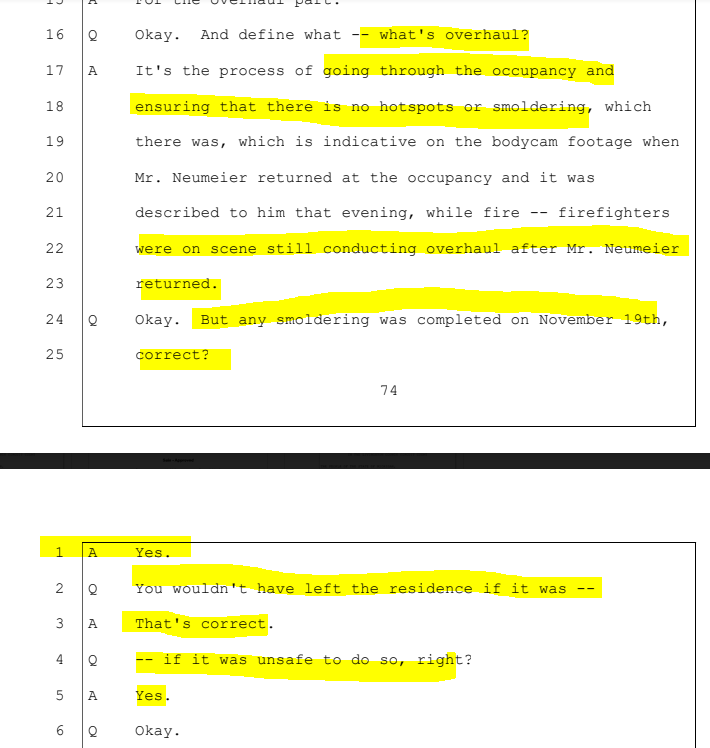
Fire Marshal Jordan Zernick failed to recall the message sent to him by the homeowner regarding the “revoked consent.” Evidence of this communication is documented in Part 1.
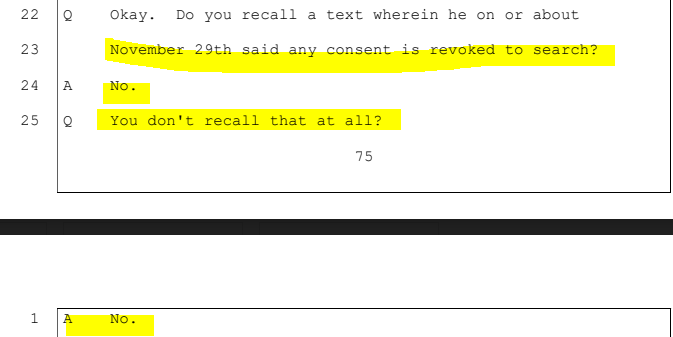
Fire Marshal Jordan Zernick admitted that there was no verbal consent to search the homeowner’s house on the night of the fire. He clarified that the only consent obtained was specifically to retrieve the DVR. This admission reinforces the homeowner’s allegations of unauthorized searches and supports claims of procedural misconduct by Hamburg Public Safety.
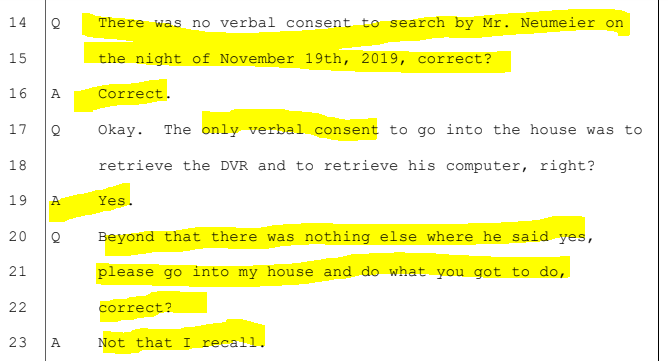
In one of his final pieces of testimony within this motion, Fire Marshal Jordan Zernick, under oath, acknowledged that the consent form was not signed until November 21st after 6 PM and that he was present at the homeowner’s house prior to this without consent. His testimony supports the homeowner’s version of events and demonstrates his forthcoming attitude regarding the tray. In both previous testimony and additional testimony within this motion, the homeowner is portrayed as forthcoming and honest throughout the investigation.

Insurance Investigator Jeremy Berard - Testimony
Jeremy Berard, a member of the public hired by the homeowner’s insurance company, testified that he never met the homeowner in person but received verbal permission to enter the house via a phone call on November 21st.
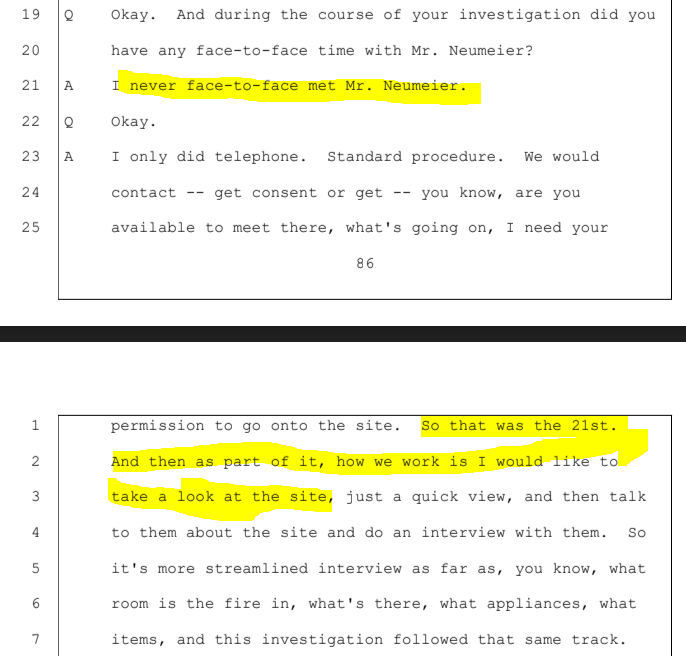
Insurance investigator Jeremy Berard testified that he did not arrive at the house until November 22nd, three days after the fire occurred. This raises significant questions about Fire Marshal Jordan Zernick’s testimony, where he stated that he waited for the insurance company before investigating the origin of the fire. What was Jordan doing inside the homeowner’s house for those three days?
Furthermore, Berard testified that upon his arrival, Criminal Investigator Sergeant Harpe was present. Jordan Zernick testified that Sergeant Harpe’s role was solely related to criminal investigations. However, Jordan had previously stated that he did not believe a crime had occurred. This contradiction is illogical and challenges the credibility of Jordan’s testimony.
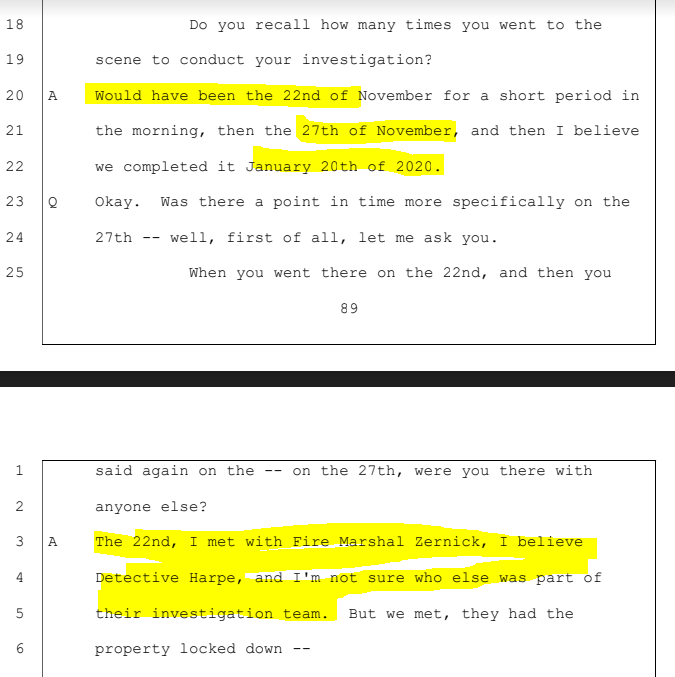
In previous documented events, Fire Marshal Jordan Zernick did not allow the homeowner to hire his own investigators to enter the house. However, testimony shows Jeremy Berard, Jay Herrick an electrical engineer, and a photographer—all members of the public—indicated that they were permitted by the fire marshal to enter the homeowner’s house to conduct an independent investigation.

Insurance investigator Jeremy Berard stated that the area under the stairs was undisturbed but also noted excavation in other areas of the basement. This indicates that before his arrival, the Hamburg Fire Department was already excavating and moving items, meaning the entire scene was not undisturbed as previously claimed.
Additionally, Jeremy referenced an “oil rag” (never tested) and was assumed to be just an oil rag at the time. At one point, Jeremy stated to the Fire Marshal that the lamp and oil constituted an incendiary device and that he needed to inform the insurance company. This behavior does not demonstrate an unbiased investigation by any means.
Furthermore, in later testimony, Jeremy Berard directed the Fire Marshal to obtain a warrant. These actions and statements suggest potential bias and inconsistencies in the investigation conducted by Hamburg Public Safety, undermining the credibility of their findings and supporting the homeowner’s claims of misconduct.

The investigator working for the insurance company suggested a criminal search warrant to the Fire Marshal. The very nature of a third party directing the government to obtain a criminal search warrant against the homeowner is biased. Additionally, labeling an item as an incendiary device without proper testing further demonstrates this bias. These actions appear to benefit the insurance company rather than ensuring an unbiased and thorough investigation.
Jeremy Berard then testified that the halogen lamp bulb was high wattage and somehow wrapped around a rag. However, it was actually first testified to as a rag wrapped around the lamp, which may have been an error in phrasing.
Additionally, the halogen bulb was never tested by either investigation team to validate their hypothesis. Furthermore, previous testimony and documentation indicate that the bulb in question was not the same wattage as initially stated.
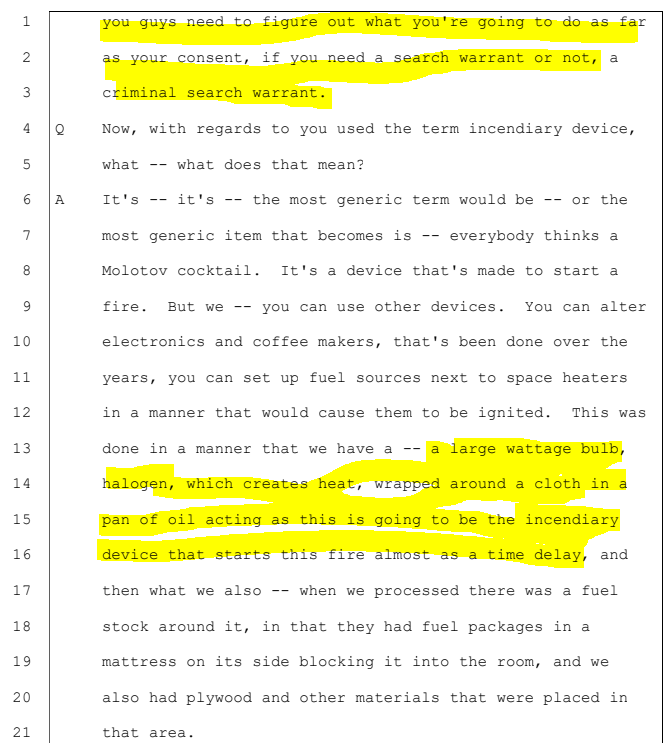
Jeremy Berard testified about what he witnessed during the video footage shown to him by Hamburg Public Safety. We assert that the timing of Mr. Neumeier leaving his house did not indicate an incendiary event (a crime). This is a crucial point because it was discussed while viewing the footage with Fire Marshal Jordan Zernick. However, days later, while in an interrogation room, the police stated that the timing of Mr. Neumeier’s departure from his house was criminal in nature. Sergeant Harpe referred to those who reviewed the footage as experts in the interrogation process.

Jeremy Berard testified that while Fire Marshal Jordan Zernick stopped the investigation to obtain a warrant, he (Berard) continued to investigate. This contradicts Fire Marshal Zernick’s previous testimony that the investigation was halted. It implies that within the area of origin, one team proceeded with the investigation while the government team paused until the warrant was secured approximately two weeks later. This investigative window by the insurance investigator and his team significantly alters the integrity of what should have been an unbiased and legitimate investigation.

Once again, testimony supports the integrity of the homeowner and his willingness to cooperate.

Upon cross-examination, the insurance investigator verified that November 22nd was his first day at the homeowner’s house, accompanied by Criminal Investigator Sergeant Harpe and Fire Marshal Zernick.
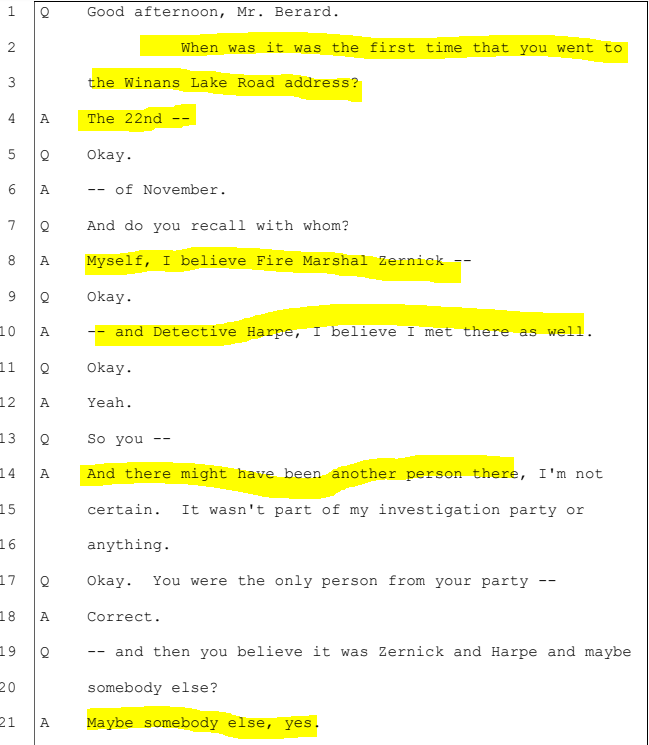
Jeremy Berard testified about the security of the house upon his arrival. However, when asked if any parts were unboarded, he responded with “no.” This is significant because the only door off the driveway that was not boarded up was the basement entry door. It would have been extremely hard to overlook, as it was located just five feet from the garage entrance, which was sealed with a padlock. This discrepancy is discussed in Part 1 and highlights that witness testimony is not always reliable. In this particular case, it represents another significant error in the fire investigation. The Fire Marshal did not have a key to this door only the key to the padlock that secured the garage. The door that was not secure by boarding gave direct access to the alleged crime scene.
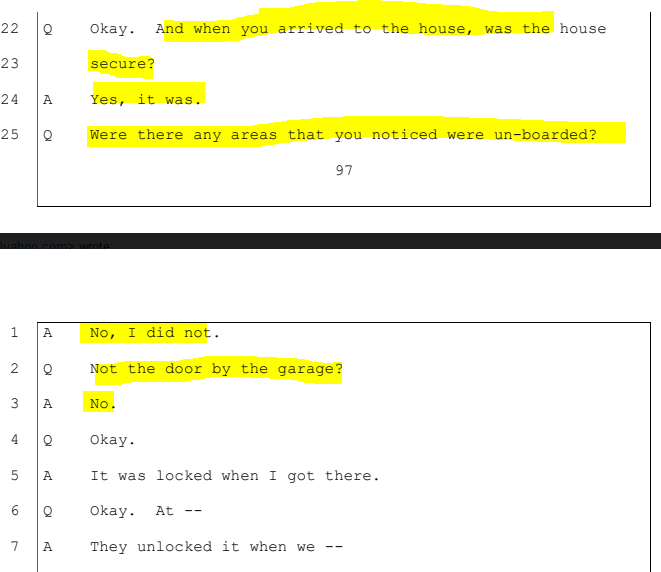
Jeremy Berard testified that he did not recall whether Hamburg believed the homeowner was a suspect. However, a log entry by Berard indicates that Hamburg claimed a crime had occurred and that the homeowner was a suspect. His failure to recall this does not mean he was unaware; rather, it highlights the significant amount of time that has passed since the fire and the difficulty for witnesses to accurately remember details.
One notable detail that Berard could recall was who the Fire Marshal allowed into the home before his arrival. This is crucial for the investigation, as the Fire Marshal stated to Berard that he, Officer Flaven, and Officer Harpe were present in the house before November 22nd. However, the Fire Marshal omitted mentioning key individuals such as the entire team from Belfour Restoration, the Fire Marshal from the neighboring city of Brighton who stated he was there with the Fire Marshal moving debris and investigating origin points, Chief Nick Miller, and others.
This omission is significant because Jeremy Berard was led to believe that the scene was undisturbed upon his arrival, which contradicts the presence of these additional personnel. The discrepancies in the Fire Marshal’s testimony and the exclusion of key individuals suggest potential biases and flaws in the investigation conducted by Hamburg Public Safety. These inconsistencies undermine the credibility of the investigation and support the homeowner’s claims of misconduct and lack of impartiality within the investigative process.
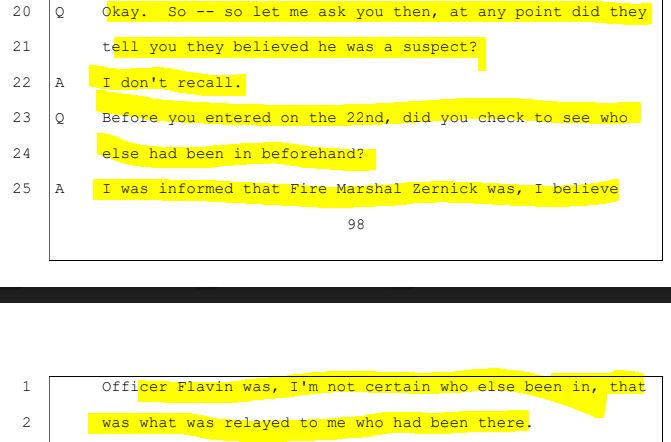
Jeremy Berard was asked whether Hamburg followed the NFPA 921 guidelines for fire investigation. He initially responded that it appeared they did, but when pressed further, he stated that he was not sure. This is a critical issue because NFPA 921 is the authoritative guide that outlines the step-by-step procedures for conducting thorough and unbiased fire investigations.
It is absolutely certain, based on testimony and reports, that Hamburg did not adhere to this court-adopted guide. This failure to follow NFPA 921 undermines the integrity and reliability of the fire investigation conducted by Hamburg Public Safety.
Additionally, Berard claimed that he received consent to enter the house, but asserted that no one else was granted consent through him. This raises a significant challenge: why were two other members of the public, an electrical engineer and a photographer, allowed to enter the house without having received consent? This inconsistency suggests potential procedural lapses and questions the legitimacy of the investigation process.
These discrepancies highlight serious concerns about the adherence to established fire investigation protocols and the potential for bias or misconduct within Hamburg Public Safety’s handling of the case. It is imperative to address these issues to ensure a fair and accurate resolution.

Jeremy Berard was also asked about the homeowner and testified once again to the homeowner’s willingness and cooperative nature.
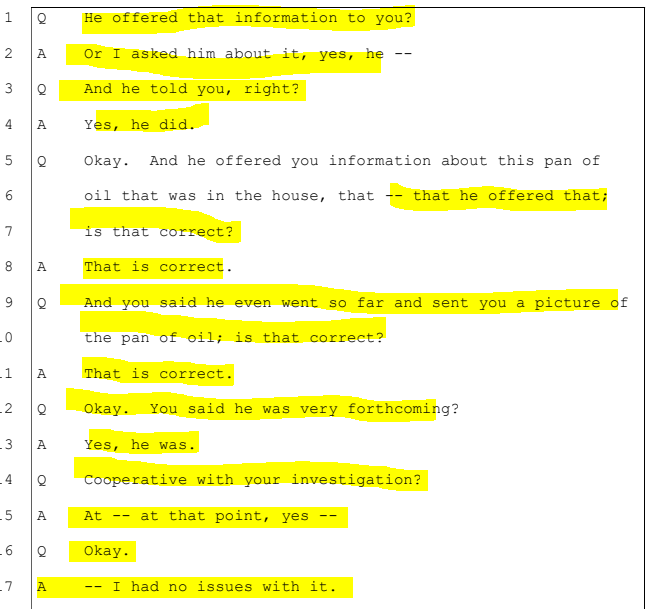
Officer Spencer Flavin - Testimony
Officer Flaven testify’s to being called to the scene by Fire Marshal Jordan Zernick
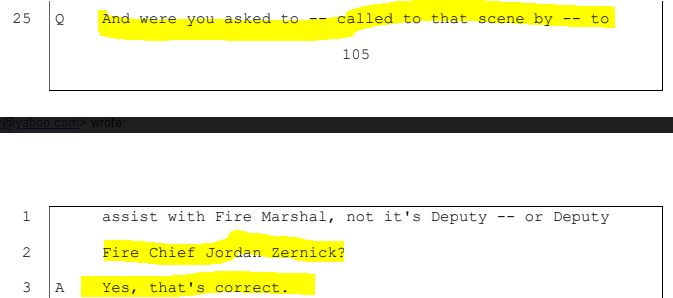
Prosecutor Idema played Officer Flavin’s bodycam footage but stopped the video just before the last few minutes. These final minutes, as shown in Part 1, reveal Officer Flavin turning off the audio on his body camera. While it may appear coincidental that the prosecutor stopped the video at this moment, it does not necessarily mean there was an intentional effort to prevent this section from being shown, as it could have opened up questioning outside the scope of the motion for that day’s hearing. or does it? We simply do not know for sure.
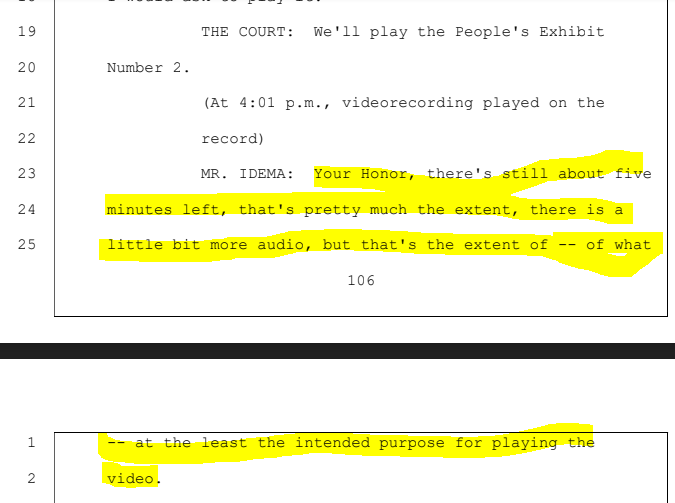
During cross-examination, Officer Flavin testified that it was Chief Miller who called him to the scene. This directly contradicts his earlier testimony, given just minutes before, where he claimed it was the Fire Marshal who contacted him.
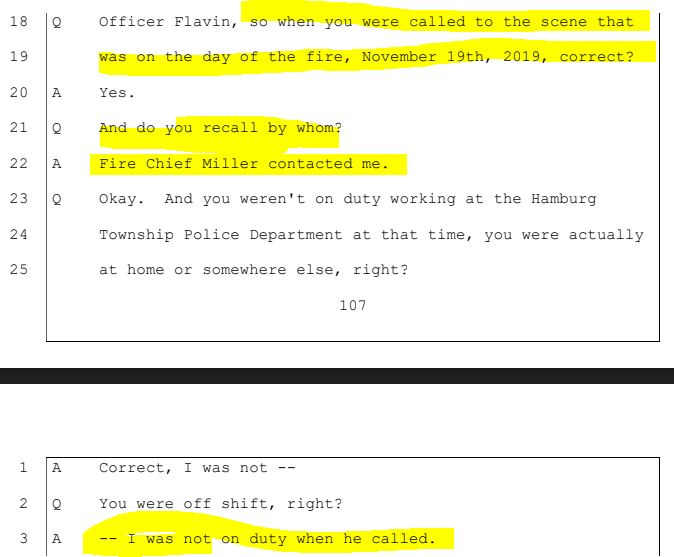
Officer Flavin admitted that overhaul was complete before he left the scene the night of the fire. This is significant because, later, the judge would reference testimony suggesting that exigent circumstances existed. However, Officer Flavin’s admission proves that after that night, no fire remained, and there was no further need for overhaul. This contradicts the rationale behind the claim of exigent circumstances and raises questions about the justification for continued entry into the home.
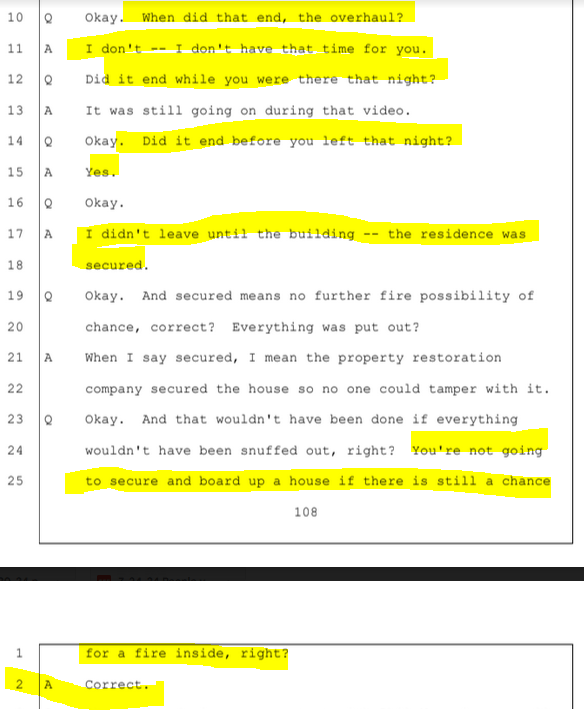
Officer Flavin testified that his purpose for being at the house was for a cause and origin investigation.

Officer Flavin confirmed the homeowner’s forthcoming nature regarding the DVR security system.
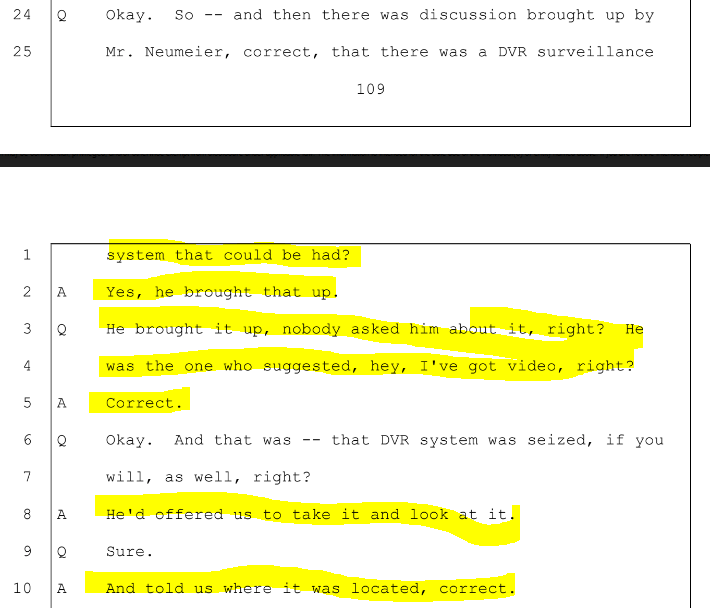
Officer Flavin confirmed that there was no written or verbal consent to search the house.
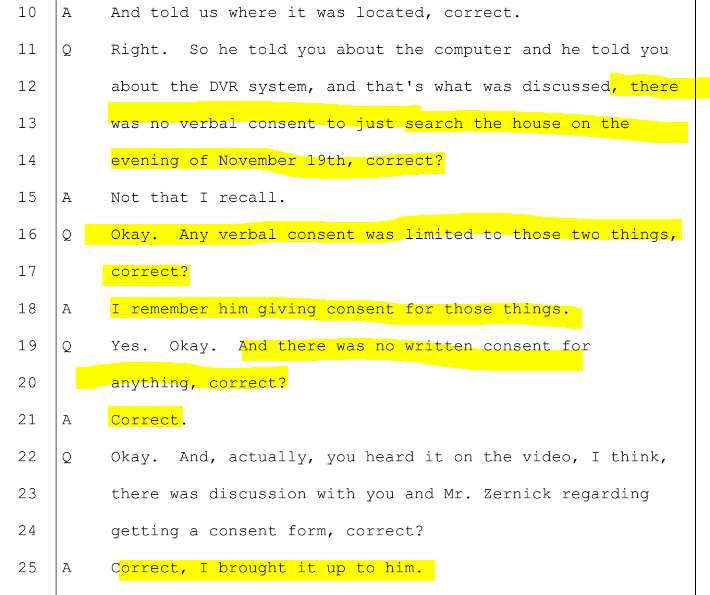
Officer Flavin also confirmed that no search warrant was obtained.
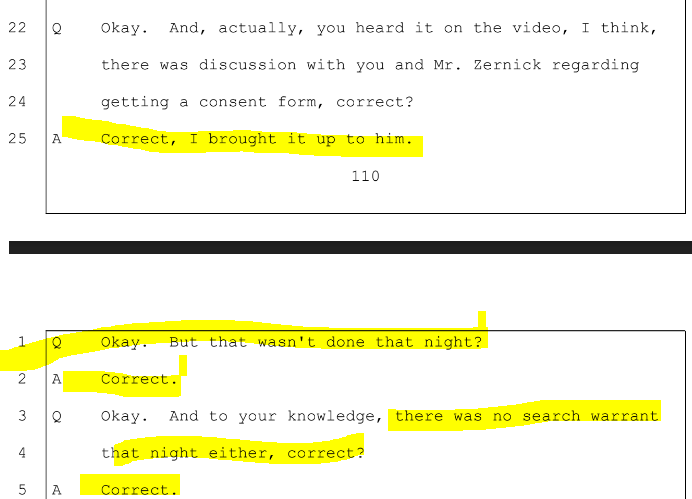
Once again, Officer Flavin confirmed the homeowner’s forthcoming nature and, in a particularly important matter, verified that the homeowner informed him about the tray of oil. This directly contradicts other narratives that alleged Mr. Neumeier did not disclose the oil or that it was the insurance investigator who informed Hamburg. In any case, this demonstrates the homeowner’s genuine concern for ensuring a proper investigation.

Officer Flavin admitted that the homeowner’s medicine cabinets were being opened during the investigation by the fire marshal. He also confirmed that the homeowner disclosed owning a gun. (Important to note that owning a gun is not consent to search nor was it asked for as you will see)
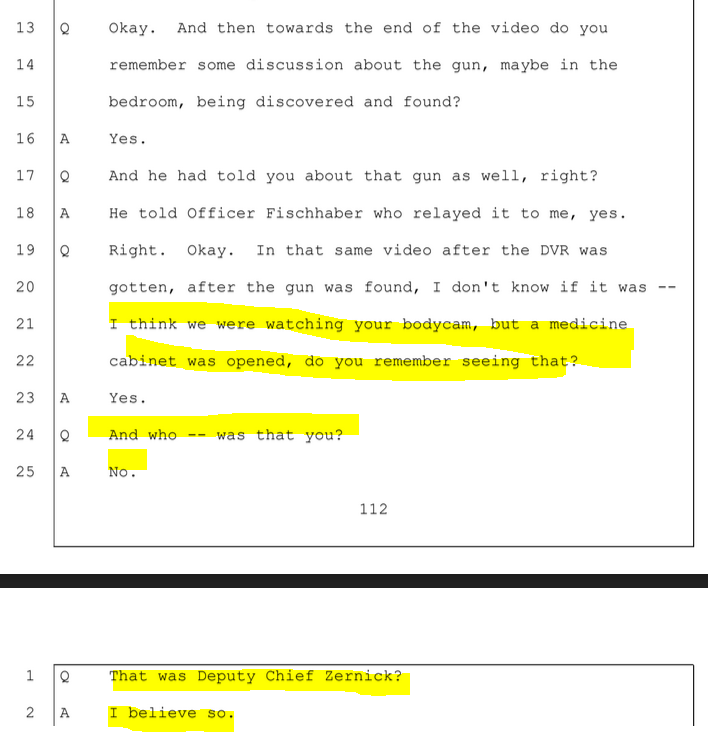
Officer Flavin testified that he did not know why the homeowner’s medicine cabinets were being searched but stated that they were looking for valuables to be secured. The homeowner did not request this, nor could Officer Flavin recall the homeowner giving them permission to search for valuables.

Regarding his body camera footage, Officer Flavin admitted to intentionally turning off his audio recording on the night of the fire. When questioned about a conversation concerning Phil being a suspect and the fire being labeled as arson, his response was that he couldn’t recall what was discussed.
It is important to note that this discussion took place while the Fire Marshal was inside his truck, which had a dash cam that was operating. However, similar to other lost video footage at the police department, the dash cam footage was mysteriously missing. It would be interesting if there was a witness to this conversation, standing just a few feet away from Flavin, which may be introduced in Part 4.

When the homeowner’s attorney asked a specific question designed to give Officer Flavin the opportunity to acknowledge what was said during the muted audio portion of his bodycam footage, Flavin responded that he could not recall anything from the conversation.

Sergeant Detective Gary Harpe - Testimony
Sergeant Harpe stated that he has training and experience in determining the cause and origin of fire and arson investigations. However, he also clarified that he is not an expert in the field. (in later testimony you would find that he does not have the ability to determined cause and origin and never has in his entire career)
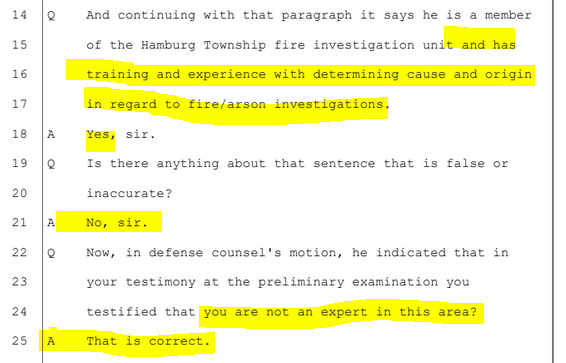
Sergeant Harpe also stated that he has never represented himself as an expert.

Sergeant Harpe admitted that he was at the house the day after the fire and the following day. However, he stated that he was there with a consent form because the Fire Marshal indicated to him that he had one. He testified that the Fire Marshal made this indication on November 20th, one day after the fire. If this statement is true, it would mean that the Fire Marshal knowingly lied to the Sergeant at the time. As testimony by the fire marshal extends an initiation of an alleged consent form out to November 21st 2019. This would also be confirmed that Kim Leeds would not even have been at work to sign a consent form until 6:00 pm on November 20th.
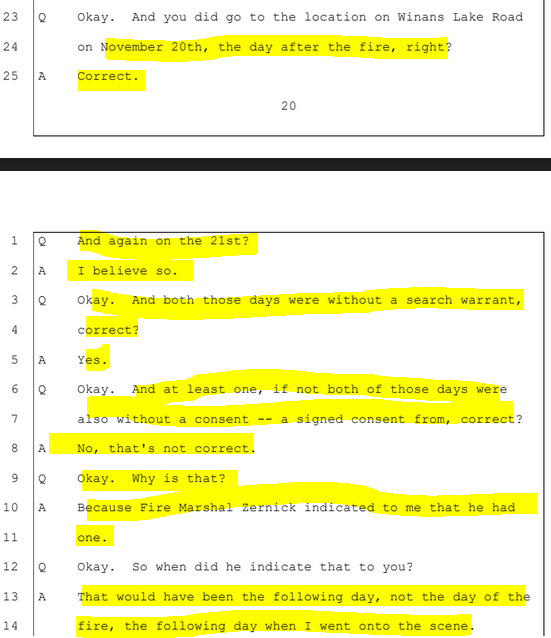
Sergeant Harpe testified that he was present in the courtroom when Kim Leeds testified that she was not working on the day of the fire and did not begin her shift until 6 PM the following day.
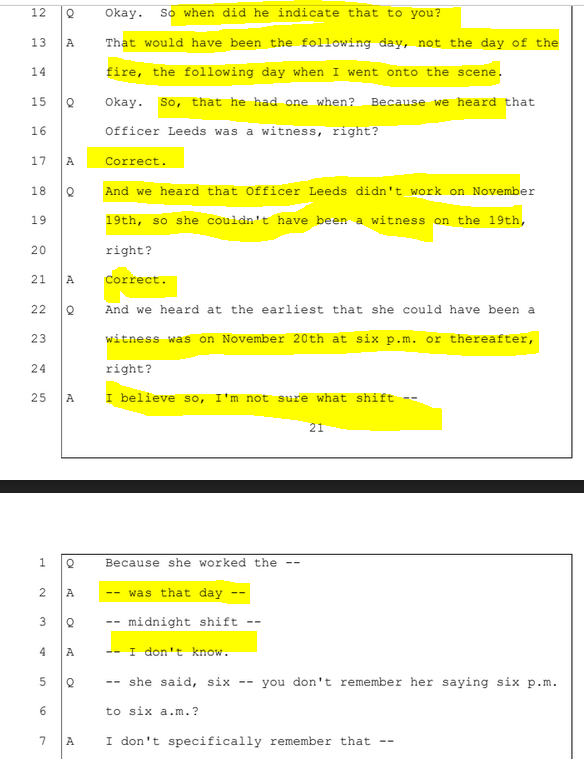
Officer Harpe testified to executing a search warrant and confirmed its continual use. This will become highly important later when discussing tabulation issues.
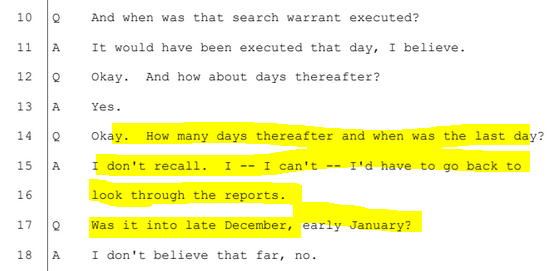
Sergeant Harpe testified to having taken a single two- or three-day arson investigation class within the last 12 years. To which he has no certification for.
This would support the homeowner’s claim that Sergeant Harpe lacks proper credentials.
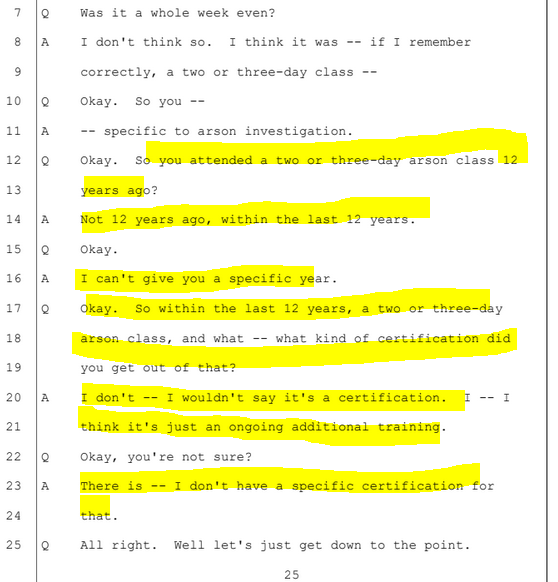
When asked if he believed he was trained and experienced, Sergeant Harpe claimed that he had some training and experience, ultimately responding “yes.”
Sergeant Harpe would not and does qualify as an investigator by NFPA 1033 standards.

However, Officer Harpe stated that he is not NFPA certified and, at no point in his career, has he ever determined the cause and origin of a fire.

Officer Harpe admitted that voluntary consent was not the reason the DVR was obtained, even tho it was stated in his affidavit it was. In reality, the DVR system was handed over on the 19th without a signed consent form.

Officer Harpe testified that there was no consent given on November 19th, 2019 (the day of the fire).
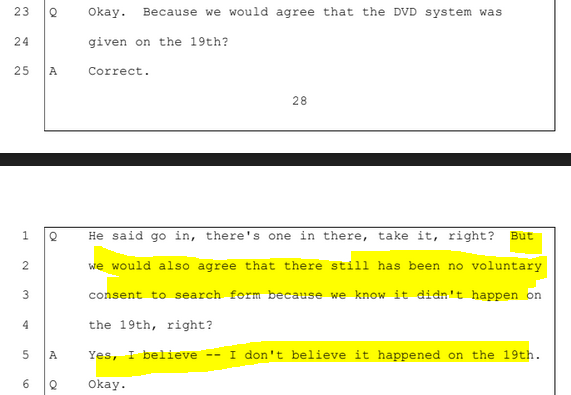
At this point, the prosecutor objected to certain parts of the search warrant being questioned.
The judge tells the defense attorney to move along and the defense rests.
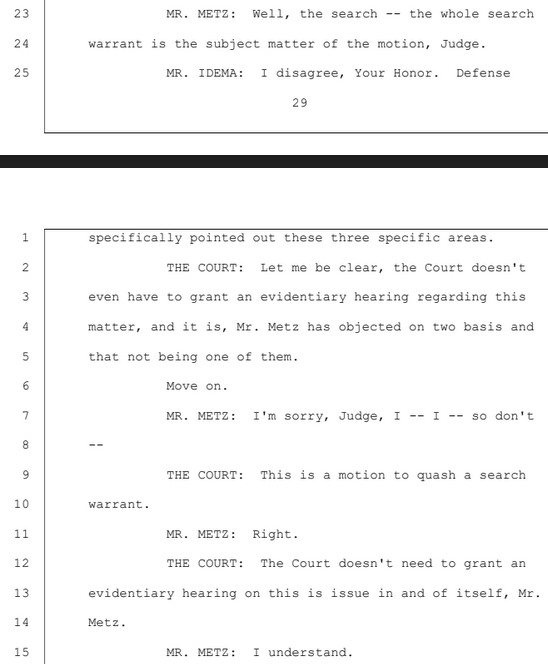

Judge's Ruling
The court was presented with testimony and body camera footage and had to make a decision on whether or not to quash the warrant and/or suppress evidence. We urge anyone who has yet to form an opinion to read the entire transcript in our evidence section. You will notice in the judge’s decision that he brings up testimony that led to his decision to deny the defendant’s motions. Some information presented by the court, as described by the testimony heard by the judge in this matter, is questionable.
Attorneys for the defendant and separately for Behindthefire.org declined to comment. While we choose not to comment directly on the judge’s statements in this section, we have highlighted parts of his ruling that stood out or appeared to contradict the testimonies presented by the police, fire department, and insurance organizations. These discrepancies raise questions about the alignment between the judge’s conclusions and the evidence provided during the hearings.


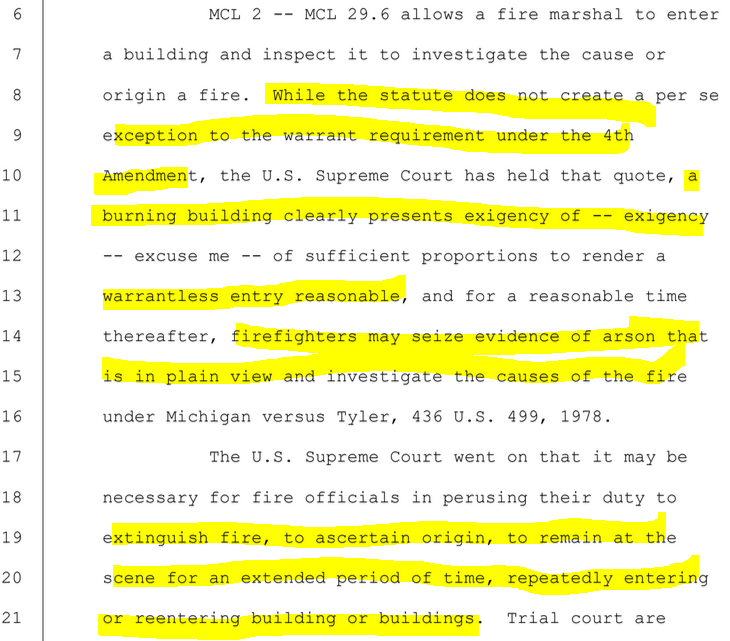

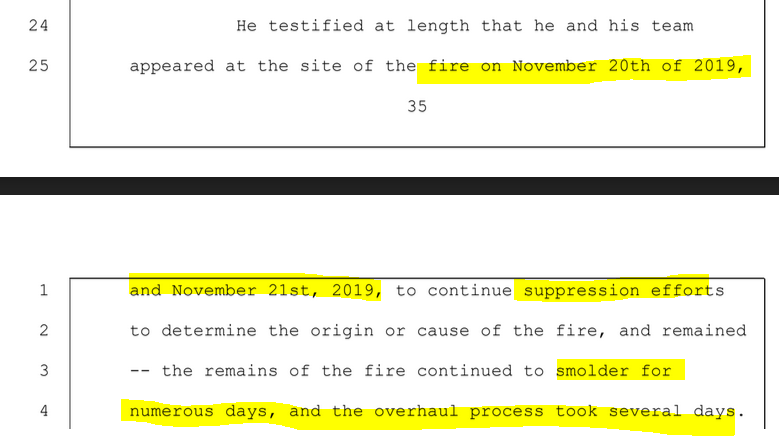

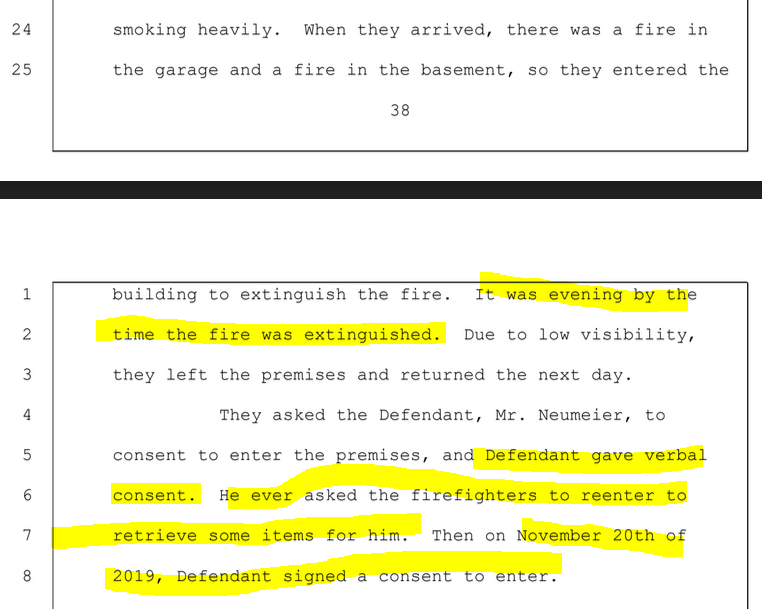
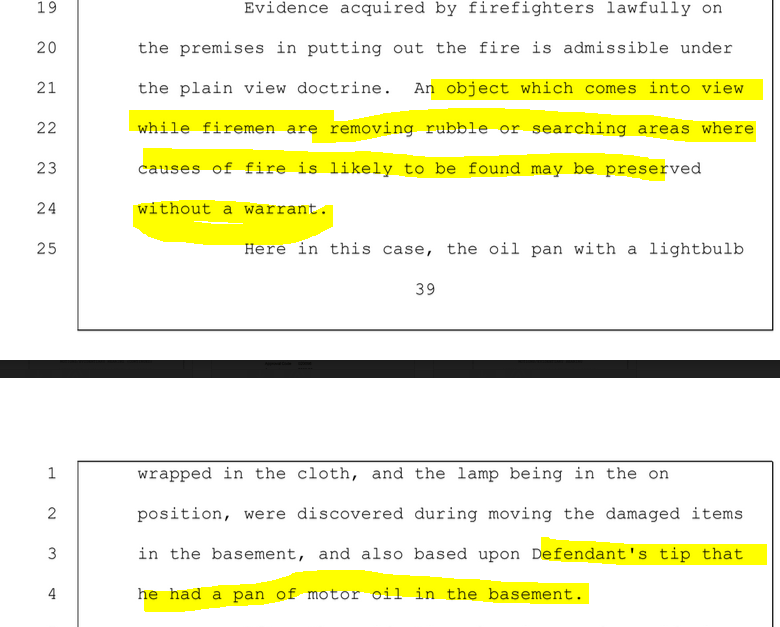
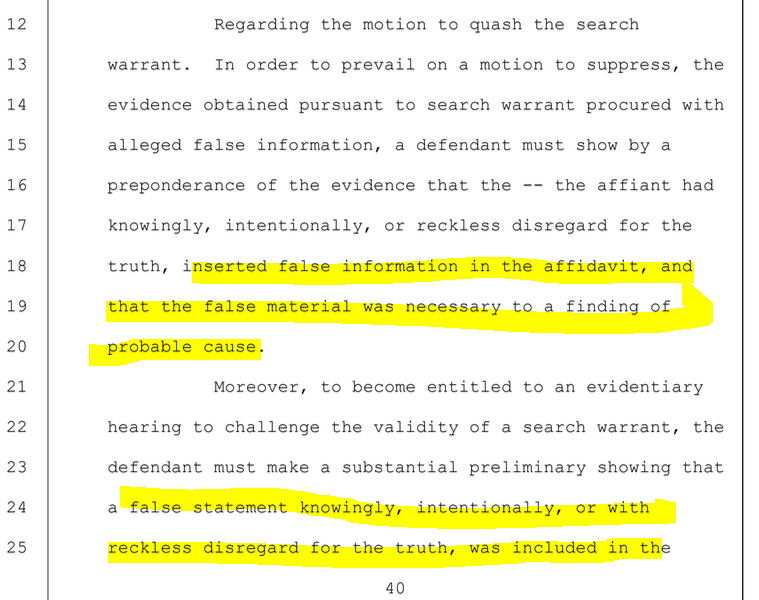
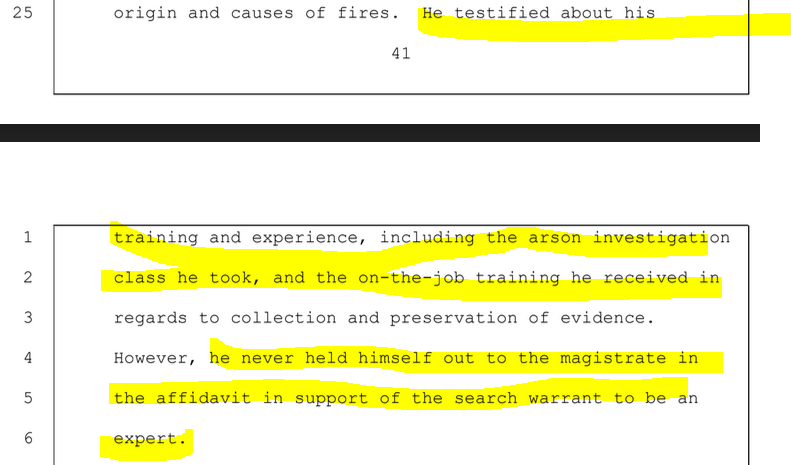



The Belfor Investigational Board-Up Discrepancy
Fire Marshal Jordan Zernick testified that the house was secured and that he was the only one with a key. He also stated in his report narratives that Belfor, a restoration company, was called for an investigational board-up to secure the entire house. However, this was not entirely accurate. Pictures taken the day after the fire clearly show a door left unsecured by Belfor. This door is significant because it provides direct access to the basement and the area of the fire’s origin.
While the homeowner maintains that he was not involved in any arson, nor does he believe any arson even occurred but the failure to secure this door poses a significant problem. It meant that anyone could access the home outside of the secured areas, potentially compromising the integrity of the fire scene. Therefore, any testimony claiming that the house was fully secured or completely boarded up would not be truthful.
This unsecured door is located less than five feet from the garage door, which had the only padlock for which the Fire Marshal held the only key. The Fire Marshal did not have a key to the door only the garage. The door’s proximity and visibility make it an obvious access point that should have been secured during the investigation.
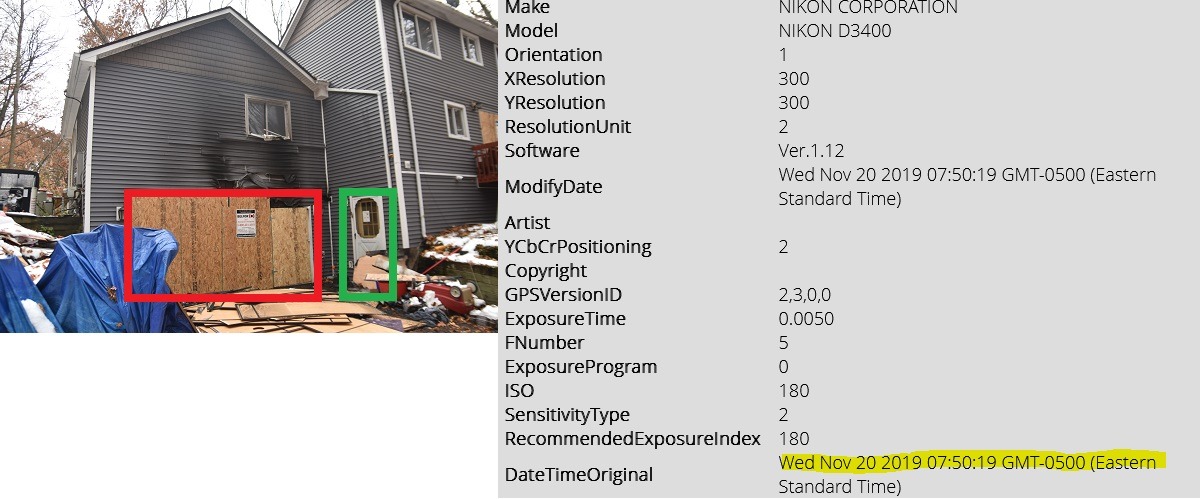
Kyle Lashbrook (Lashbrook Mechanical)
In a rare event, we have added an additional piece of newly discovered information as of 9/25/2024. A message was sent to Behindthefire.org regarding a Facebook post made by an HVAC company out of Ann Arbor, Michigan, called Lashbrook Mechanical, run and operated by Kyle Lashbrook. His company was hired by the current owner of the house to remodel and repair the HVAC system.
The link to the post was sent to Mr. Neumeier, and it was verified to be his former house. After this verification, communication was made with the company. It’s important to note that this company has zero affiliation with Mr. Neumeier or Behindthefire.org, and the post appears to be unsolicited by anyone on Mr. Neumeier’s team or representation.
The post suggests that the HVAC system may have contributed to the fire or its spread. We reached out to the company and asked the owner a few key questions, which confirmed statements made in Part 1 by another third party. We discovered that a cavity between the joists in the basement, which led to the top of the house, was flagged by the general contractor currently working on the house. This indicates that the initial build may not have been done properly, as smoke should not have been able to travel between floors had a proper barrier been in place.
Additionally, Hamburg Public Safety did not hire their own electrical, mechanical, or HVAC engineers to evaluate the system during the original investigation.
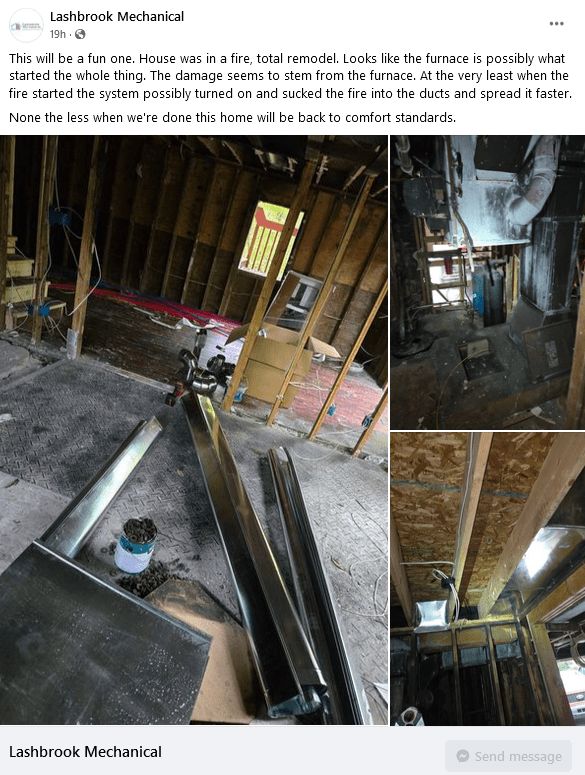
In terms of a fire investigation a lot about how the house was constructed, which was not documented as being evaluated by Hamburg is significant. This raises many serious questions, that’s for sure. The fire spread, smoke movement, oxygen supply, and compromised fire containment are all matters that were not taken into account in the evaluation of duct chases by Hamburg’s investigation team.
These are critical factors that should be thoroughly evaluated in any fire investigation. The failure to consider how duct chases can influence fire behavior raises serious concerns about the thoroughness and accuracy of Hamburg’s investigation. This could have significant implications for understanding the fire’s development and the building’s safety compliance.
Kyle Lashbrook, who made the initial post regarding his work on the house at 7809 Winans Lake Rd, clarified that he was contracted to handle the air distribution system. Upon arrival, the heating system was missing. The old air conditioner was still present inside the ductwork with significant smoke and heat damage—including melted drain lines, melted drainage pan, melted wiring, and insulation.
He noted that there are several cavities being used as return duct chases, counting a total of five that reach the upper level. Upon his inspection, many of the return and supply ducts were significantly damaged from what he can only assume was heat. The metal grilles were melted, and he stated, “Smoke won’t do that.”
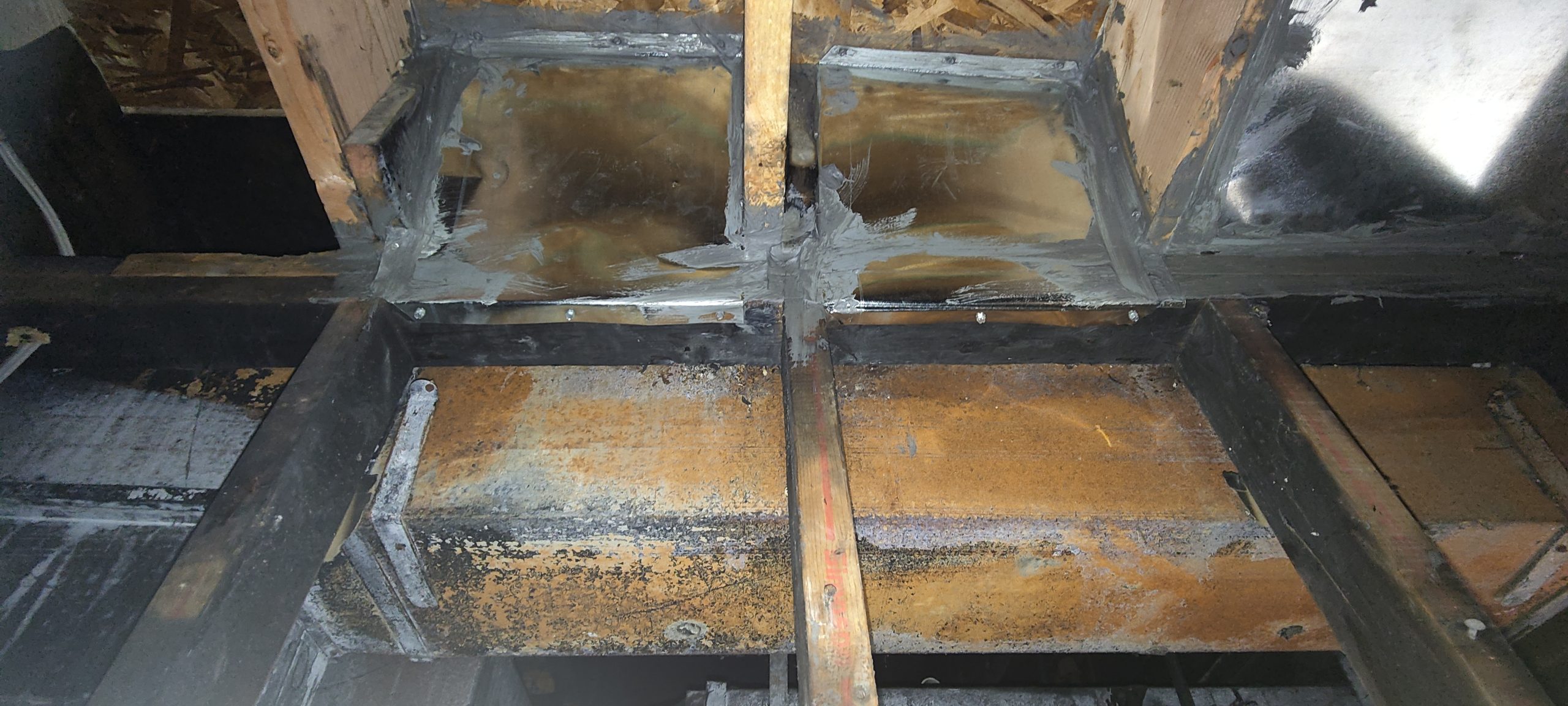
I can attest the damage seems to be located in the basement region and garage area and shows significant discoloration due to heat traveling throughout the duct system. The only role I could say as a possible option was that the AC or furnace had come on during the fire, and that's why the ductwork had such significant damages. I would say, given the damage to the ductwork, a fire or significant amount of heat was present inside the ductwork at some point in time. I cannot attest as to when this happened, but it seems likely the HVAC system moved air in the home, which helped spread the fire into the duct system. The existing duct on site is not sealed and would not be airtight. This would, in theory, allow smoke to enter the walls, upper levels, and attic space. The way the returns were routed through the house isn't exactly abnormal in my experience. I would not say the way the returns were run was 'bad quality,' but standards for airtightness in ductwork are much higher today than in the past.
Kyle Lashbrook (Lashbrook Mechanical)
Motive? "What motive?, it wasn't arson!"
Follow-up Interview with the Homeowner Regarding Alleged Motives
The day after the live posted interview, we reached out to the homeowner for more insight into what the prosecution might consider as a potential motive for the alleged arson. When interviewed, the homeowner stated he couldn’t think of what the prosecution’s suspected motive would be. He clarified that his taxes were clearly not an issue and provided proof to that (in part 1), while he had liens, two of them were mistakenly placed and were subsequently removed by those companies. His taxes did not hinder any of his businesses or investments at any time, and he’s never been in trouble for any tax evasion, as substantiated by the IRS.
In the interrogation, Officer Harpe suggested that a repossession or foreclosure was an issue. The homeowner provided documentation showing that it was not a foreclosure but a land contract forfeiture, and he even provided proof that it was to transfer a property owned by his mother.

We pressed the homeowner further, as during the preliminary exam, the prosecution brought up insurance and suggested he was “over-insured.” Mr. Neumeier responded:
“I never increased my insurance, AMICA did. I contacted AMICA during the entire process I was remodeling to make sure my solar panels were protected, and renovations and they said it was already within the coverage. They would offer more coverage but I denied it when it was offered as I believed it was sufficiently covered. Other than that, I never requested any rate increases. In fact, when I first bought the house, I had a different insurance company and actually changed companies to lower my rate. AMICA automatically increased my coverage every year, the prosecutor would have you believe I did this and it’s simply not true “
When asked if homeowner had any proof, he provided documents showing that his insurance benefits were automatically increased without any request from him.
Verification of Homeowner’s Insurance Actions
We were able to verify and follow up on documents submitted showing that the homeowner actually changed from one insurance company to another to save money. In 2016, the new company, AMICA, inspected the property and determined it warranted over $500,000 in coverage. According to their records, AMICA inspected the property and noted the renovations and improvements made to the home. The homeowner opted not to increase the coverage rate, meaning he chose not to increase the insurance coverage despite the property’s higher valuation. This information supports the homeowner’s claim that he did not over-insure his property, countering any allegations that he might have increased coverage for fraudulent purposes.
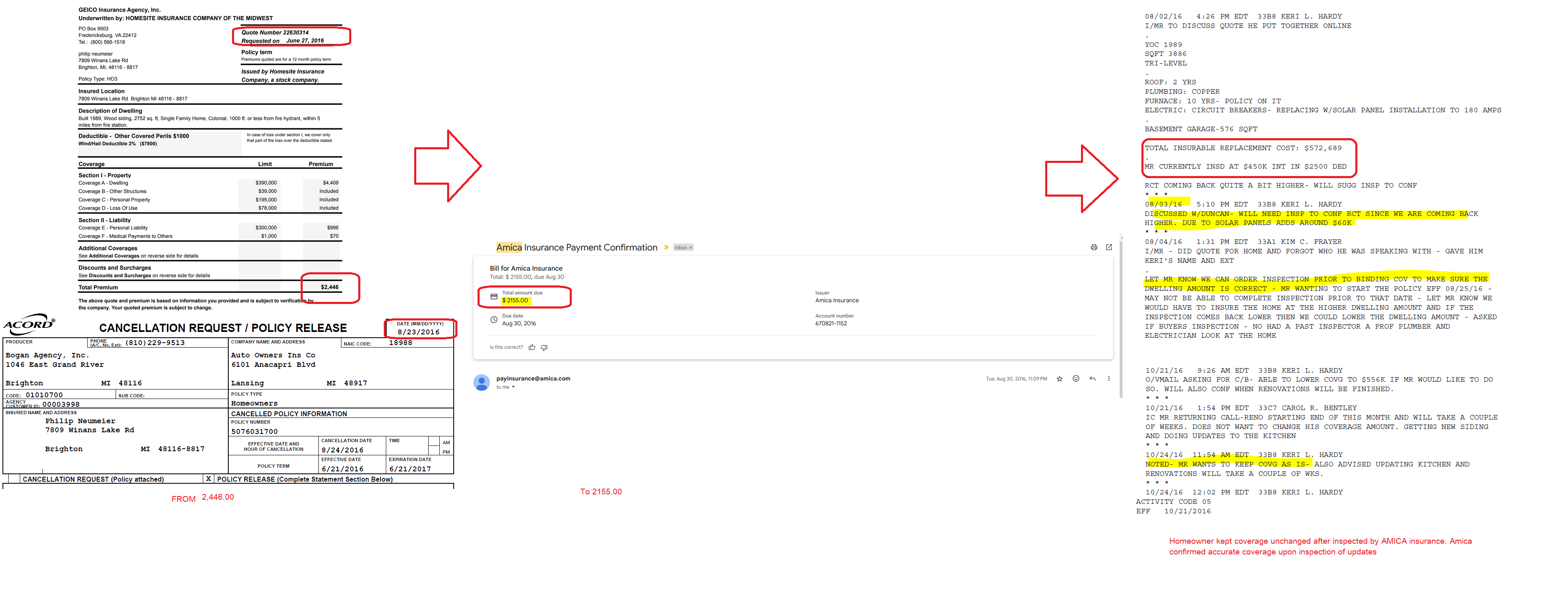
Confirmation of Automatic Insurance Coverage Increases
Regarding the homeowner’s statement that his insurance coverage was increased by the insurance company without his direct request, we have confirmed this to be accurate. He supplied letters from the insurance company, dated annually, indicating that his coverage was automatically increased based on AMICA’s assessment of rising building costs. We verified each letter and found them to be authentic and consistent with the homeowner’s previous narratives. Below is the latest example months before the fire happened. The other letters will be found in the evidence room.
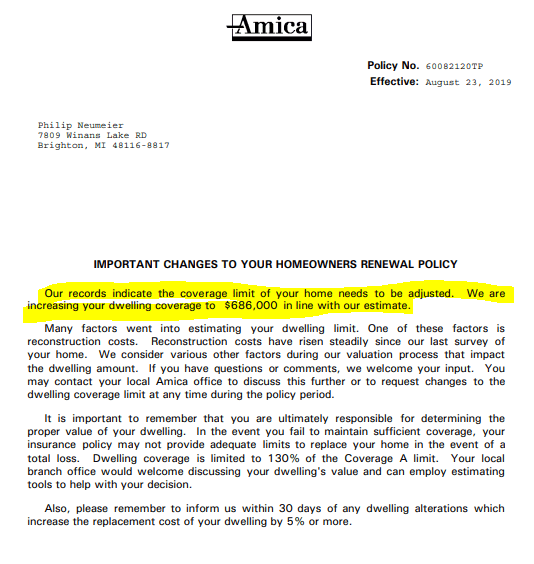
The homeowner went on to say:
“I have gone through every document I could and reviewed all testimony. Anything that hinges on their perceived motive is disqualified just by documentation from third parties. My house payments were all made on time and paid. I chose to retire from the workforce due to my sleep issues and wanting to raise my son at the time. I had investments to financially secure me during the time off. I did not live an extravagant life in terms of financial potential/ability; I could have easily invested my money into things frivolously, but I did not do this. My house was purchased at reo, and at the time of the fire, it was worth nearly double or even triple what I paid. The equity in the house alone would absolve any notion that I couldn’t have access to funds if I needed them. Nobody knew how much money I had at the time; I rarely talked about it with anyone. If I wanted someone to have some money I’d donate it, I normally kept any other details of money to myself.
“I do not think at this point they would believe money is an issue, harm to others is an issue, or anything criminal in nature. I just think it was an extremely poorly done investigation. I do not want to talk too much about the legal defense on this matter, but there were some questions that could have been easily answered. They even pulled my insurance file, as stated in the last hearing I attended, meaning there could be zero assumption that my house was bare, as every single item was documented by the insurance company from each room. The cost to rebuild the house and the value of the items within my house would match with the insurance coverage set by the insurance company not me.”
They need to have a reality check. Do they really think anyone in a dispute over taxes would burn their house down just to pay the IRS? They should consider how ridiculous that notion is. First, if the house is destroyed, you are required by the mortgage companies to rebuild or repair it. So if the insurance company even pays out, you would first have to devote those funds to rebuilding your house. If you have extra—which would be unlikely at the time due to the premium on building supplies—then the IRS would take those funds, which would not even come close to paying the disputed amount. On top of that, let’s not forget you still have a mortgage to pay.
Let’s consider this tax situation if I didn’t want to dispute it: wouldn’t it make more sense to:
A. Just pay it. They have my personal financial statement and know I could.
B. Refinance or take a loan against the equity and pay the IRS.
C. Sell the house and pay the IRS.
D. Sell any other properties or take equity out of other properties and pay the IRS.
E-Z. 100’s of other ways to resolve any perceived “issue” that are legitimate and financially more sound and sane than crime.
Once again, when Officer Harpe did a lien search, he failed to mention that my other properties had no real mortgage debt associated with them. Instead, the narrative was that I “had financial issues,” yet my “issues” were already taken care of. The IRS has a multitude of ways to handle disputes. I even told Sergeant Harpe that I was not at the point where I wanted to have any dealings with them. That remains true to this day.
If they would have just asked before accusing me I would have been able to explain with documentation that when my father passed away from cancer that he left me some money. This money I opted to have the taxes taken out before receiving funds and send them directly to the IRS. When I filed that year I forgot the money was already taken out and I included it in my income by mistake. This would also go for missed business write-offs. So when and if the IRS ever wants to sit down with me I will simply show them the form and they can verify it. Hamburg has access to my personal financial statement. I do not think anyone who verified it would conclude there would be any financial motive. No crime was committed. There is zero benefit to a house fire in my situation and I have to challenge them to find one because I can say with certainty this fire cannot be spun by anyone factually as being a benefit in any way.”
This interview highlights the homeowner’s perspective on the prosecution’s suggested motives and his efforts to provide documentation refuting any related claims.
The Homeowner's Connection with Officer Leeds, Fire Marshal Jordan Zernick, and Officer Flavin
Outside of the homeowner’s investigation, we have discovered a connection between the homeowner and certain officers and fire department members. Given that Hamburg is a small town, it is not entirely surprising that Officer Leeds, Officer Flavin, Fire Marshal Jordan, and the homeowner all attended the same high school. While some attended at different times, it’s noteworthy that Officer Flavin graduated the same year as the homeowner.
When reached for comment, the homeowner confirmed that he did know Officer Flavin and had connections with the Fire Marshal. While this information doesn’t necessarily imply any wrongdoing or directly affect the case, it has recently come to light and adds some context to the relationships between the parties involved.
Disclaimer: This article includes snippets of testimony, evidence, and information, which are provided for informational purposes only and should not be interpreted as legal advice. Behindthefire.org, its associates, writers, or contributors do not make any claims or assertions regarding the content of this article. All individuals mentioned are presumed innocent until proven guilty in a court of law. Any references to criminal activity are allegations, and no one has been convicted at this time. We encourage you to review our evidence page to see everything in its entirety. Readers are strongly advised to use this information responsibly, conduct their own research, and consult with a qualified attorney for legal guidance specific to their situation.
Behind The Fire - Hamburg, MI is proudly powered by WordPress
